

Podium
Belmont Hill’s History and Social Sciences Magazine



An important note: All opinions and ideas expressed in The Podium are the personal opinions and convictions of featured student writers and are not necessarily the opinions of The Podium sta!, the Belmont Hill History Department, or the Belmont Hill School itself.

The Sta of Volume IX of The Podium Back Row, Left to Right: Ben Adams, Davis Woolbert, Mikey Furey, Jaiden Lee, Brandon Li, Suhas Kaniyar, Teo Rivera-Wills; Front Row: Wesley Zhu, Ernest Lai
Cover photo from BH Archives
Published by the Belmont Hill School 350
Printed by Belmont Printing Co.
Designed with Adobe InDesign and Adobe Photoshop
Letter from the Sta!
Dear Reader,
We are extremely excited to share Volume IX, Edition II of The Podium with you. For the seniors on the sta!, this will be the final edition published during their time at Belmont Hill. A total of thirteen fantastic student works are included in this issue, covering a dazzling array of topics in history, current events, and politics.
This edition opens with “History on the Hill”, in which Brandon Li ‘26 thoughtfully examines World War II through the Belmont Hill Panels. As always, The Podium received numerous outstanding student paper submissions for their annual op-ed competition. Belmont Hill students were asked about their views on ChatGPT as a grading tool, the necessity of the Electoral College, and whether or not the automobile industry should transition to electric vehicles. The three winners were Daniel Chen ‘26, Jack Ramanathan ‘26, and Rylan Dean ‘26, and we thank all the students who submitted op-eds.
Also included in this edition are three research papers nominated by the Belmont Hill History Department. Monaco Prize-winner James Keefe ‘25 begins by discussing the anti-slavery movements from the U.S. Catholic community during the Ante-Bellum and Civil War eras. Next, Will Days ‘27 examines the struggles of migrant workers in China and the hukou system of residential registration. Finally, Riley Marth ‘27 somberly reflects on the Rape of Nanjing and the lessons that can be learned from such a horrific event. We sincerely congratulate all these students who were selected for their outstanding work.
In addition to these papers, several sta! articles are included in this edition. Ben Adams ‘25 and Christopher McEvoy ‘25 surveyed the Belmont Hill community and its sentiments toward the 2024 presidential, Senate, and House elections. This issue closes with five miscellaneous essays, covering themes like the House and Senate races, politics in the Olympics, the legality of military occupation of the West Bank, student protests in Bangladesh, and Elon Musk’s impact on Trump’s campaign.
We would again like to thank everyone who submitted work to The Podium, and give a special thanks to Glenn Harvey, our faculty advisor. Thank you for picking up a copy of this edition of The Podium, and happy reading!
Ernest Lai ‘25, Wesley Zhu ‘25 | Editors-in-Chief
Mikey Furey ‘25, Davis Woolbert ‘25 | Executive Editors
Jaiden Lee ‘26, Brandon Li ‘26, Christopher McEvoy ‘26 | Associate Editors
Ben Adams ‘25, Bradford Adams ‘26, Lucien Davis ‘26, Suhas Kaniyar ‘27, Sam Leviton ‘27, Eli Norden ‘26, Henry Ramanathan ‘26, Teo Rivera-Wills ‘27 | Sta Writers
Mr. Harvey | Faculty Advisor

World War II Through the Belmont Hill Panels
Brandon Li ‘26
Ever since Belmont Hill was founded in 1923, the school has required graduating members of Form VI to carve a panel as part of their graduation requirement. Through these carvings, seniors often choose to reflect items or themes of significance to them. These panels are then hung up and displayed around the school for future observers, reminding them of our institution’s storied past and the unique individuality of the many men who were shaped by it.
Some seniors choose to illustrate sports, extracurriculars, or hobbies they participated in during their time at Belmont Hill; others portray some concept or life lesson they may have learned. However, many panels also provide fascinating accounts of the historical events taking place in America and around the world at the time of each senior’s graduation. Such history-oriented panels provide unique commentary on cultural movements, political events, and global news through the fascinating lens of a Belmont Hill senior about to enter the adult world.
Specifically, this article will focus on World War II as told through Belmont Hill’s panels from 1940 to 1945. World War II had a profound impact on Belmont Hill. Several faculty members departed as they were drafted to fight overseas, even including the headmaster at the time, Thomas R. Morse. Enrollment at the school sharply dropped as families anticipated financial di!culties from the war. Even clubs and extracurricular o erings at Belmont Hill shifted to provide an educational experience more tailored to wartime: Theater, debate, and glee were replaced by First Aid, navigation, and motor mechanics. By analyzing a few of the panels produced at Belmont Hill during World War II, this article hopes to provide greater insight into the thoughts and concerns of everyday high schoolers throughout this war.
Even though the United States had not yet entered World War II when this panel was created in 1940, the themes represented in the carving demonstrate how the possibility of America joining the war was very much present in the minds of Belmont Hill students at the time. The empty rocking chair, sad-looking dog, cane, and hat represent home life, fami-
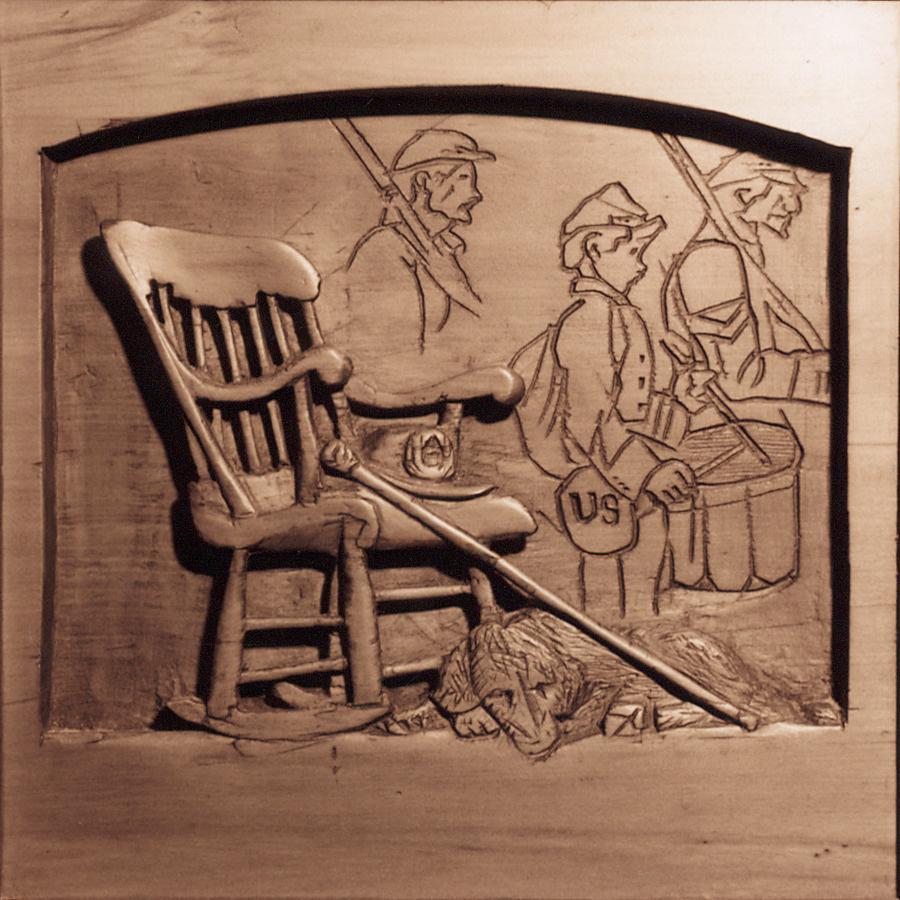
ly, and comfort. These are juxtaposed with the faded figures of American men marching o to war, highlighting the personal sacrifices soldiers make when heading o to fight for their country. The carver, George Lawrence ‘40, likely chose this topic knowing that if the United States were to join World War II, he would be drafted to serve and fight overseas. Lawrence’s panel indicates that Belmont Hill students paid close attention to World War II in its early stages, knowing that if the U.S. decided to enter the war, their futures would be greatly impacted. The 1940-1941 school year was a time of increasing fear, uncertainty, and awareness about World War II at Belmont Hill. Seven boys from England had joined as refugees of German bombings, and they undoubtedly would have carried their knowledge about World War

II with them. This panel, authored by James Knowles ‘41, shows a French Croix de Guerre (Cross of War), which was a military award given to French soldiers for acts of heroism in battle. Marianne, the personification of the French Republic, is placed at the center of the iron cross, with Republique Francaise inscribed around her. Knowles was referencing the Nazi occupation of France at the time and the establishment of the puppet “Vichy France” regime, intending to convey themes of French resilience, hope, and struggle against the foreign invaders.
The attack on Pearl Harbor in December 1941 finally pushed America into joining World War II, and many panels from the class of 1942 reflect the tension and excitement of war. The U.S.

government used patriotic slogans and propaganda to reinforce a culture of nationalism, unity, and individual responsibility. The most famous of these was the phrase “Loose lips sink ships,” which cautioned citizens of inadvertently sharing sensitive wartime information with the overseas enemy. This panel, by Robert Baldwin ‘42, likely sought to portray this; a hand silences the cartoonish man, and the bold text – QUIET! – alludes to the wartime emphasis on secrecy. Baldwin’s panel is one of many that demonstrate how Belmont Hill students questioned and reacted to the cultural shift as America was violently and suddenly brought into World War II.
As the war neared its end, the Battle of Iwo Jima shocked the American public with its bloodiness. Japanese soldiers fought with extreme resolve and near-suicidal determination, knowing that American troops were encroaching on the Japanese mainland with every
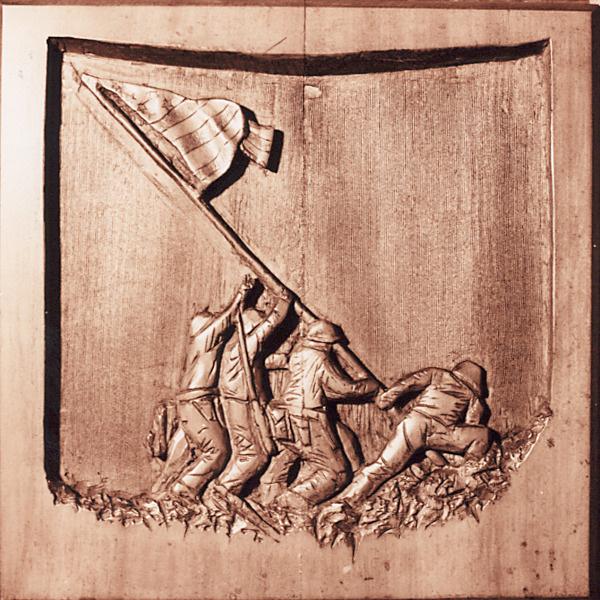
island that was captured. This panel, by Thomas Kau man ‘45, depicts an iconic photograph taken of U.S. Marines raising the American flag atop Mount Suribachi during the battle of Iwo Jima. Kau man’s decision to carve this image demonstrates the extent to which students at Belmont Hill were moved by the sacrifices and resilience of American soldiers during World War II.

The Podium | History on the Hill
Preserving Representation: Why the Electoral College Still Matters
Jack Ramanathan ‘26
Since the framing of the Constitution, our founding fathers have understood the necessity of holding fair and just elections, especially for the o!ce of the president of the United States. However, determining how a “fair and just” election would be held presented a confusing challenge to the framers. During the Constitutional Convention of 1787, many different plans to elect the president were opinionated. Some delegates argued for Congress to elect the president, and others insisted on a popular vote to determine the holder of executive o!ce. Ultimately, a compromise between the two - known as the Electoral College - was reached. For the next 237 years, The system has served as a vital mechanism that ensures smaller states have a voice and has prevented the dominance of urban centers over the entire country.
The Electoral College has allowed for a wider representation of America to have a more meaningful and impactful vote in presidential elections. It also prevents highly populated urban areas with dense media markets from deciding the fate of the presidency. Such a system forces candidates to campaign across the country to places like Vermont or Wyoming, which has more influence than their population alone would suggest, preventing large states from monopolizing elections. The Electoral College also addresses the Founders’ fears of “tyranny of the majority,” where, in a democratic race, the majority party pursues its own objectives at the expense of minority parties. If a popular vote were to decide who would hold the o!ce of the president, a candidate that would solely represent problems in big cities, such as Los Angeles, New York City, or Chicago, would be elected over a di erent candidate that would support the needs of other, more rural states. That being said, the Electoral College can still elect a president that supports the needs of
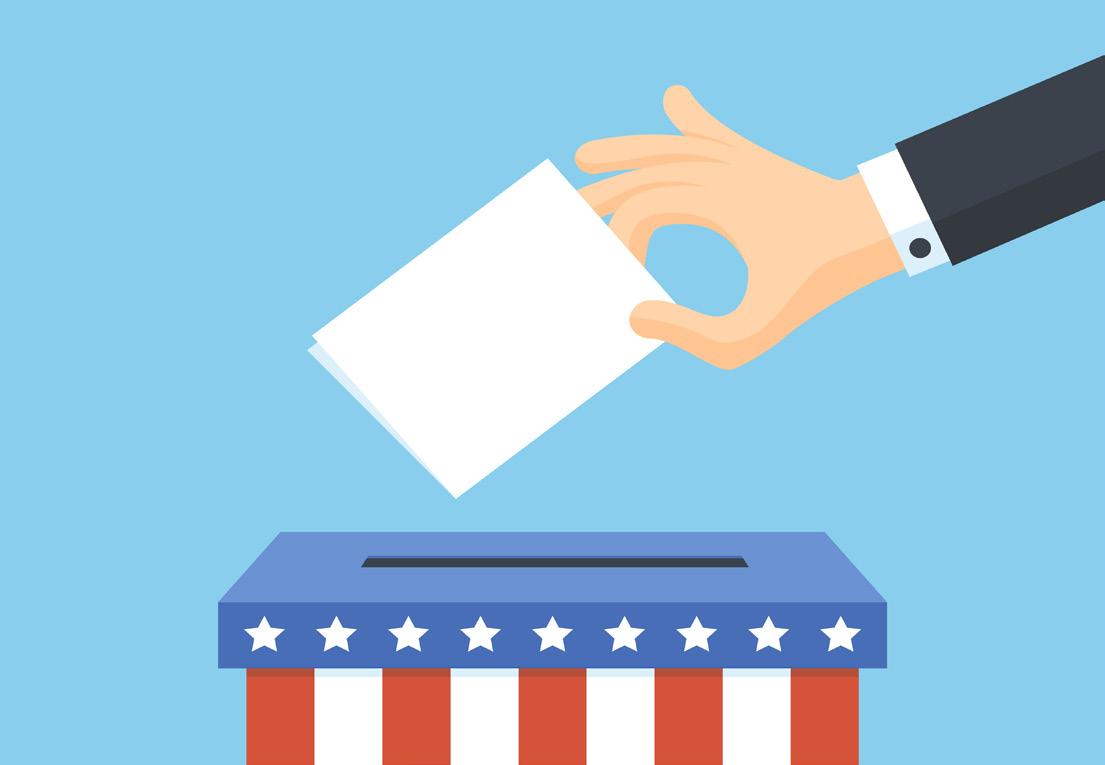
cities. However, it also requires the president to be more mindful of problems more applicable to all of America rather than specific or concentrated areas.
While some citizens may argue that a popular vote would be more democratic and thus fair to elect a president, they would also overlook the intention that our founding fathers had; they designed the Electoral College to protect the country from the risks of a purely majoritarian society, where highly populated cities would determine the outcome of elections. Centuries later, that same argument that the founders had is in some ways even more applicable today, with over 80% of Americans living in cities.
Rather than creating an amendment to abolish the Electoral College, we should consider reforming the system and allocating the amount of electoral votes in each state. By doing so, the concerns of fairness in elections without dismantling the entire election system would be better addressed.
In a country as diverse and vast as the United States, the Electoral College remains the best method for balancing the needs of all States, and ensuring proper representation within each presidency.
Should Teachers Be Able to Use ChatGPT to Grade?

In recent years AI has become a transformative technology in numerous industries. One of the most controversial uses of AI is in school by both teachers and students. Teachers are often burdened with large numbers of papers and tests to grade, and AI could certainly expedite the process with consistency. However, teachers should not be allowed to use AI in grading as it lacks the nuance required for e ectively grading subjective assignments and diminishes the human relationship that is central to the classroom environment.
AI lacks the emotional intelligence and depth to properly grade subjective assignments such as essays, research papers, or creative writing. At first glance, the advantages of AI grading are obvious. When it comes to objective assignments such as multiple choice, math, or grammar and syntax questions, AI is able to quickly and e ectively determine their correctness. Essays and creative projects are far from questions with a simple one-dimensional correct answer. They require students to use their critical thinking skills, synthesize diverse sources of information, and craft arguments from the student’s personal experiences and insight. These assignments require an evaluation process beyond technical accuracy and incorporate emotional resonance and meaning, areas where AI currently struggles to perform e ectively. AI also lacks the ability to
grasp context in complex writing assignments. Whether it’s historical context in a history paper or an underlying theme in an English paper, this information may not be present in an AI data set, resulting in the AI not being able to fully grasp the implications of this context.

AI’s lack of emotional understanding also destroys the student-to-teacher emotional connection that is crucial in a classroom environment. Feedback from teachers is often more important than the grade itself, as it allows the student to adapt and improve. A teacher’s comments provide sympathy, motivation, and guidance, allowing the student to rethink their approach. AI-generated responses no matter how
accurate at identifying technical errors, cannot often have the same depth of human insight that allows students to thrive and grow.
Ultimately the decision to allow teachers to use AI for grading should be made carefully. It is certainly an e ective tool to minimize and teacher’s workload and reduce human error. However, it should not replace human judgment entirely, or replace the relationship aspect of teaching. As for students, if AI becomes integrated into the classroom environment it should be used as a tool for enhanced learning, for example creating practice questions, or asking good questions, but should not be used as a shortcut in the student’s educational experience.
Driving in Reverse: The Truth About Charging Forward with Electric Vehicles
Rylan Dean ‘26
The international automobile industry should not transition toward electric cars in the near future under the current circumstances of their sustainability. In the ever-substantial world of a rising climate and increased carbon dioxide emissions, the question of electric cars is at the forefront of every automotive company’s list. Nearly 20% of all carbon emissions annually are a result of gas-powered cars. Not only does the operation of these vehicles lead to an outpouring of CO2 into the atmosphere, but also the delivery and manufacturing. The environmental results of these issues are terrifying to say the least. Without immediate action, the earth’s average temperature may see an extreme increase of 8.6°F by 2100, leading to the annihilation of ecosystems, an increase in destructive storms, and a severe displacement of communities.
It would only make sense for the solution to this problem to be that we should replace all gas-powered cars with electric vehicles in order to immediately cut our emissions before its too late. However, by taking a closer look at the underlying implications of both the production and disposal of these electric automobiles, a valid argument can be made for why we should wait to integrate them into society. First of all, the average carbon emissions from the assembling of an electric and gas car are both around seven to ten tonnes, showing no signs of improvement on the electric side. However, the production of an average electric automobile battery emits an additional nine tonnes of carbon dioxide into the environment. So before either of these cars is on the road, the electric car has already released double the amount of carbon dioxide than a gas-powered car would in manufacturing.
The story does not end here either. The
idea of charging cars rather than filling them up with gas might sound like a simpler and more sustainable solution to lowering carbon emissions; however, most charging stations worldwide actually receive their energy from fossil fuel or gasoline-powered power plants. These sources emit around 400-800g of carbon dioxide per kWh of charging (the average battery capacity of an electric car is 60kWh/300 miles). The di erence in carbon release into the atmosphere between electric and gas-powered cars might not be as large as we think. This raises a question that almost all car companies and national governments are asking right now. Should the car industry really be aiming at a full electric fleet on the roads by the end of the decade?
The answer to this question is twofold. On one hand, you keep with the old and continue the production gas powered cars that continue to destroy the air with tailpipe emissions. On the other hand, you make a full switch over to electric cars but see basically no positive outcome due to the fossil fuel-powered charging stations. The solution to this problem is simplicity and patience. Charging stations running on renewable energy sources such as wind turbines and solar panels only emit around 36g of carbon dioxide per kWh, significantly less than power plants. If we made a complete shift to electric vehicles within the next year, charging stations would become overloaded and only worsen the emission situation. Therefore, national governments should direct most of their focus toward creating charging stations that run on renewable energy rather than trying to increase the number of electric cars on the road. Only once all the problems of supply chain and charging emissions are solved should we begin to discuss the idea of electric cars taking over the roads.

RESEARCH PAPERS
“A Practice So Repugnant to Catholic Feelings”: U.S Catholic AntiSlavery movements in the AnteBellum and Early Civil War Eras
Winner of the 2024 Monaco American History Prize
James Keefe ‘25
Introduction
On the eve of the United States’ independence from Great Britain, Catholics numbered less than 25,000 (approximately 1% of the overall population of the original 13 colonies) and were concentrated primarily in the more tolerant Middle Colonies.1 However, after religious freedom was protected constitutionally by the fledgling American republic, the Catholic Church’s demographics expanded rapidly.2 By 1850, the Church counted approximately 1.75 million faithful.3 Much of this expansion was due to an influx of people from the Catholic Old-European - predominantly Ireland and Germany.4 While Protestantism was still the largest Christian sect in the United States, Catholicism had become the largest single denomination.5
This massive and diverse growth also gave birth to a significant backlash in the form of anti-Catholicism and nativism in the U.S., which portrayed Catholics and immigrants, among other things, devils seeking to undermine American democracy. Many prominent figures in the United States embraced these ideas, spurring the brief significance of the reactionary, anti-immigration, and xenophobic Know-Nothing political party.6 However, the Catholic Church persevered through such adversity by balancing assimilation into Americanized culture with the preservation of distinct religious and ethnic heritage.7
This shift in the Church’s demographics mirrored its stance on slavery. Many of the first U.S. Catholics inhabited the Catholic hav-
en of Maryland and supported the institution of slavery. However, this began to change as the Vatican and the Society of Jesus became more skeptical of slave ownership.8 Ultimately, the influx of immigrants into America shifted the balance of power - and the Church’s centre - towards foreign-born Catholics, who would occupy many of the clerical positions in the Church by the Ante-Bellum period.9 These foreign-born Catholics were relatively new to America. Although many held strongly negative views on the “peculiar institution” of slavery, many more were focused primarily on simply trying to make it in their new country, before rocking the boat politically on behalf of another population. This sentiment was only further influenced by the aforementioned rise in nativism. This duality would persist for decades and provides insight as to why a majority of the Catholic faithful failed to take a strong stance against slavery.10
During the Ante-Bellum and early Civil War eras, the Catholic Church in America counted among its ranks many staunch anti-slavery advocates and had received a significant degree of anti-slavery guidance from the Vatican; however, despite this influence, the American Catholic Church at large remained neutral on the issue. Three examples of this conflict provide insight on this failure to win hearts and minds First, while Catholic anti-slavery movements did gain traction via prominent figures such as Daniel O’Connell as well as the duo of Bishop John Baptist Purcell and Fr. Edward Purcell; all saw their work undermined by a population of faithful that was more concerned with issues of inte-
gration, Catholic oppression abroad, or fears of nativist backlash than activism. Next, the Vatican, while publishing several anti-slavery encyclicals, directed its spiritual and moral guidance towards Portugal and Spain, both overwhelmingly Catholic countries that remained active in the international slave trade and largely left America’s slavery question as a secondary issue. Lastly, Irish-born Bishop John England and his allies ultimately won more hearts of the faithful and the direction of the Church based on their neutral approach and focus on combatting nativism via appeasement rather than conflict on the issue of slavery. Ultimately, despite strong voices to the contrary, neutrality with respect to slavery was more convenient, appealing, and expedient to a rapidly changing American Catholic Church.
By way of context, Catholicism existed in the New World since first contact with mainland Europeans. Spanish and Portuguese explorers, almost universally Catholic, often sought to expand their faith in addition to their flag as they moved across the continent.11 These early explorers were followed by the French - also overwhelmingly Catholic - and then lastly the English - primarily Protestant.12 Catholic missions exploded across Latin America and New France (extending from Eastern Canada to the Mississippi Delta). Religious orders such as the Jesuits, Franciscans, and Dominicans thrived during this period, influencing politics, theology, and society.13 One notable cleric among these orders was Bartolomé De las Casas, a Dominican priest and the first anti-slavery advocate of importance from the Old World. Through his decades-long life in the Americas, De Las Casas fiercely battled the system of Encomienda.14 A practice which claimed evangelization and protection as its goal, but it resulted in the de-facto enslavement of Native Tribes.15 De Las Casas continually attempted to sway the Spanish Crown toward his
views - and eventually succeeded in doing so - by publishing scathing reports of atrocities committed against the native population.16 These actions, among others, resulted in De Las Casas being coined as a “friend to the Indians”.17 However, these missions and Catholic presence were largely absent from the 13 colonies of England - which became the United States of America.18 Indeed, with the potential exception of Maryland, Catholics in the British colonies - few that there were - were absent from positions of influence. They were excluded from residing in certain areas, barred from holding Mass (except in Pennsylvania), and treated as second-class citizens.19 These conditions were exacerbated during subsequent conflicts between the three colonial powers of Britain, France, and Spain, which ultimately culminated in the Seven Years War. At the end of the hostilities, France’s Catholic banner was near-banished from the New World.20 Although the Spanish presence would persist for decades after the war, by and large, Eastern North America firmly fell into the hands of British-backed Protestants.21 By the Early 1800s - around the same time as the beginning of Ante-Bellum slavery - Spain too lost the plurality of its colonies at the hands of nationalist rebellions in Latin America.22, 23
In addition, with respect to the issue of slavery, the Catholic Church had a long, complicated, and notable history. For a significant portion of its ministry, the Church existed in nations where slavery was not only permitted but quotidian.24 In fact, early Christians - to whom Catholics trace back their faith - were often themselves enslaved by Roman masters.25 Due to slavery’s common nature over centuries, a!rmed by its presence in the Bible itself, the Church primarily viewed the institution as it would any other state of being - simply preaching Christian morality in its exercise.26 Although reprehensible today, there was a significant theological movement that

believed slavery could be moral should the master treat his slaves as “brothers” and equals.27 Even then, however, a relationship such as this was nigh impossible due to the inherently hostile nature of slavery. Thus, although there is documentation to support that the Church stepped in during the worst cases of abuse, it had not fundamentally and completely broken with the legacy of the institution prior to the creation of the United States.28 Yet, as time went on, the Church began to become more socially conscious, specifically concerning the issue of slavery. Although scholars debate when precisely slavery was o!cially outlawed in the Church - with some saying as early as 1435 and others arguing for as late as 1965 - they generally agree that, particularly in the Vatican, a movement against slavery had been fermenting and gaining traction by the late 18th century.29
Anti-Slavery Voices: O’Connell & the Purcells
During the Ante-Bellum era and the early stages of the Civil War, Anti-Slavery Catholic advocates, such as Daniel O’Connell and brothers Bishop John Baptist Purcell and Fr. Edwards Purcell, became among the most influential Catholic figures in America. These men fought painstakingly against the “peculiar institution”; however, due to a multitude of factors, their missions did not resonate with the majority of Americans.
Daniel O’Connell was a renowned Irish Catholic political leader during the Early 19th century and was immensely popular among the Irish population in Ireland and America.30 Born in County Kerry in 1775, O’Connell would become a lawyer and leader in the movement to liberate Ireland. A proponent of peaceful protest, O’Connell was known to gather crowds of over 100,000 for his rallies.31, 32 He also took an aggressive stance against slavery in the United States and desired to turn his fellow Irishmen against the institution.33
However, though Daniel O’Connell’s work was immensely impactful on the Church in Ireland, it was largely lost on the American Church due to the distraction of Irish-Americans, who were more concerned over civil liberties being stripped away by the British gov-
ernment in Ireland. Additionally, even in the height of his American mission, O’Connell was considered to be something of a foreigner. He was an Irishman born and raised, and Ireland is where he called home, as his detractors would point out.34 This would be used to attempt to discredit O’Connell’s scathing anti-slavery criticisms, which were primarily directed at America.35
Even so, O’Connell had a long history of combatting American slavery, attempting several times to rally people to put an end to the institution for good. The American abolitionist Frederick Douglass toured Ireland and heard O’Connell speak at an Abolitionist rally in Dublin. O’Connell declared to his audience,
“I have been assailed for attacking the American institution, as it is called,—Negro slavery. I am not ashamed of that attack. I do not shrink from it. I am the advocate of civil and religious liberty, all over the globe, and wherever tyranny exists, I am the foe of the tyrant; wherever oppression shows itself, I am the foe of the oppressor; wherever slavery rears its head, I am the enemy of the system, or the institution, call it by what name you will. I am the friend of liberty in every clime, class and colour. My sympathy with distress is not confined within the narrow bounds of my own green island. No—it extends itself to every corner of the earth. My heart walks abroad, and wherever the miserable are to be succored, or the slave to be set free, there my spirit is at home, and I delight to dwell.” 36
Another famed black abolitionist, Charles Lenox Remond, was deeply moved by rebukes like these and wrote to William Lloyd Garrison in 1845 after his own tour of Ireland: “My Friend, for thirteen years I have thought myself an abolitionist, but I had been in a measure mistaken until I listened to the scorching rebukes of the fearless O’Connell”. However, perhaps most notable of O’Connell’s pushes to end American Slavery was a petition he signed and circulated, “An Address of the People of Ireland to their Countrymen and Countrywomen in America.37” Noticing the surging Irish American population in the United States, O’Connell firmly believed that if united, they could be a political force unleashed against slavery. Further, understanding that all the Irish Cath-
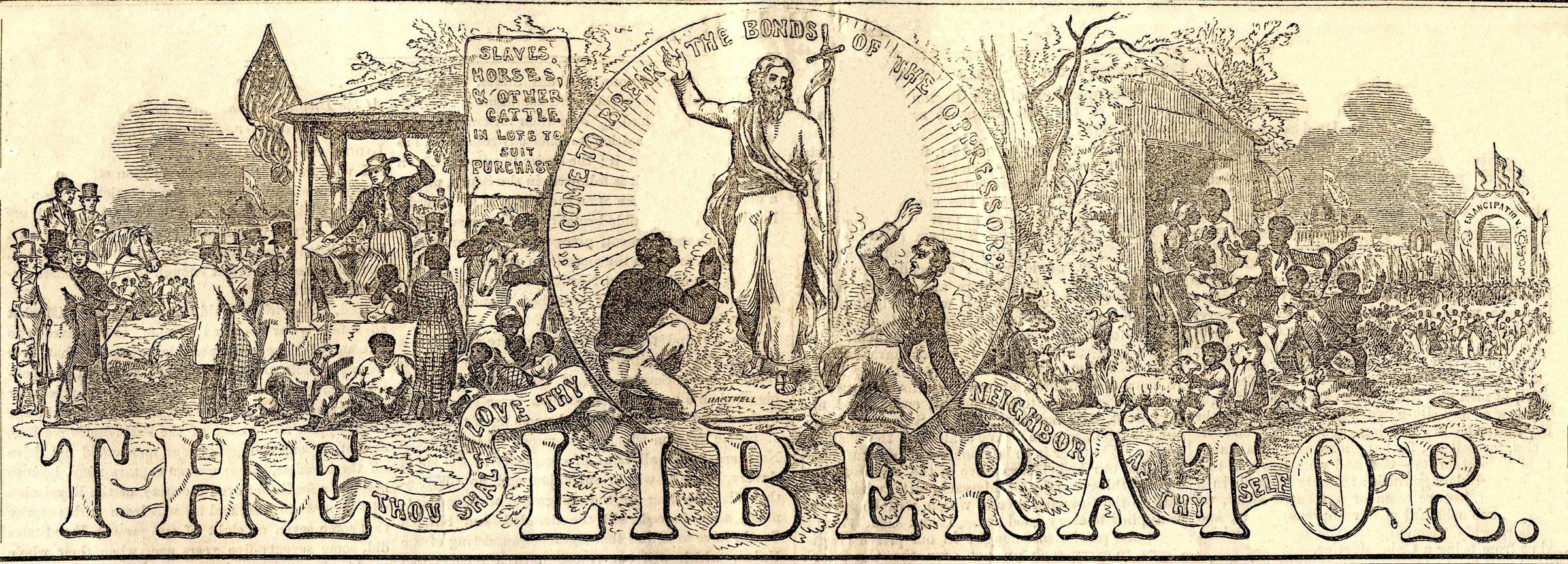
olics had left a brutal system of oppression at the hands of the British, O’Connell believed the Irish would be the most likely to empathize with the struggle of Black Americans in their newfound country.38 As stated in “An Address …”, “Irishmen and Irishwomen! Treat the colored people as your equals, as brethren. By all your memories of Ireland, continue to love liberty [and] hate slavery - cling by the abolitionists and in America you will do honor to the name of Ireland.” 39 While O’Connell may not have been completely wrong in the logic of Irish-American understanding of the African American plight, history would prove him naive to hope that this sentiment would lead to Irish-Americans turning en masse against their country of refuge.40
The O’Connell-backed petition began in Ireland, where it was distributed across the country by O’Connell’s many Irish allies, rapidly gathering approximately 60,000 signatures in mere weeks.41 Notably, O’Connell found the most adamant supporters of the petition to be Irish Catholic clergymen, with many rallying members of their parishes to the cause. Thereafter, Lenox Remond - at O’Connell’s instruction - departed Ireland for Boston with the petition in hand.42 There, he met with several other abolitionists, namely William Lloyd Garrison, George Brayburn, and Wendel Phillips (among others). They organized an event at Faneuil Hall where the petition would be unveiled and read to the public. Boston’s community was ecstatic to witness the reveal of the
document, and Faneuil Hall was packed with 5,000 people - about 1,500 of whom were Irish immigrants.43 There, they were treated to rousing speeches by the event organizers and others - many painted the similarities between the Irish struggle in Ireland and the Black struggle in America. Phillips even gave a particularly noteworthy testament to the nature of the Catholic Church, stating:
“African lips may join in the chants of the Church, unrebuked even under the proud dome of St. Peter’s; and I have seen the colored man in the sacred dress pass with priest and student beneath the frowning portals of the Propaganda College in Rome, with none to sneer at his complexion... [A] long line of Popes, from Leo to Gregory have denounced the sin of making merchandise of men - that the voice of Rome was the first to be heard against the slave trade - and that the bull of Gregory XVI, forbidding every true Catholic to touch the accursed thing, is yet hardly a year old.44”
Ultimately, however, it may have been that the then-current situation in Ireland resonated more with these Irish Bostonians. Daniel O’Connell’s other loyalty resided with the Irish Repeal movement, which strove to repeal the Act of Union forced upon Ireland in 1800. This legislation stripped many of Ireland’s previously given freedoms and amounted to a crackdown on Irish self-governance by the British.45 This enraged a large swath of the Irish people and the many Irish Americans who still sympathized with the su ering of their homeland.46
As both slavery and repeal were topics discussed at this Faneuil Hall gathering, one could reasonably presume that the latter reason attracted the Irish Americans at least as much, if not more, than slavery. An examination of the aftermath of this event confirms this assumption. Although the O’Connell-endorsed petition had an overwhelmingly positive response initially - with the Irish in Philidelphia, in particular, flooding anti-slavery o!ces to obtain copies of the petition, over time, this response soured.47 First, Irish-owned or backed newspapers began to cover the anti-slavery cause with a degree of skepticism, reemphasizing instead the importance of repeal.48 While the articles still opposed slavery in its most fundamental sense - they clearly stated that the priorities of Irish Americans should be the support of a free homeland and not fraying bonds in their new nation.49 From there, criticism of the petition escalated, particularly among the Democratic-led political machines who were the primary supporters of the Repeal movement in the United States.50 Seeing a connection between Repeal and anti-slavery as potentially disastrous for the overwhelmingly pro-slavery Democrats - who drew many immigrants into their fold via direct aid upon their arrival - leading Democrats ripped into O’Connell, hoping to dissuade the Irish from endorsing his views.51 Although many Irish would stand up for their hero, precious few would publicly endorse his views in the face of their benevolent Democratic machine bosses.52, 53
Ultimately, O’Connell’s e orts - although legion - failed to sway a preponderance of American Catholics against slavery, particularly the Irish-Americans that he targeted. For these Americans, O’Connell and his allies stretched themselves too far. He alienated many who would otherwise have been sympathetic to the petition’s cause via its scathingly public critiques on slavery, as such positions would upset many of America’s immigrant-driven, Protestant-led and pro-slavery Democratic political machines who were the source of many economic and social opportunities for Irish-Americans. Such rhetoric calling for these Americans to “bite the hand that fed them” was unappealing for those reaping the benefits of the status
quo.
Bishop John Baptist Purcell and his brother, Father Edward Purcell, faced similar opposition to their anti-slavery ideals. Like O’Connell, both were Irish-born; however, the Purcells di ered in station - one being Archbishop and the other a Priest in the American Catholic Church.54 Both of these posts granted them a di erent but significant sway over the a airs within their own Archdiocese of Cincinnati and a large amount of influence over the Catholic Church in the US.55 Interestingly, both men are often credited as the first prominent American Catholic figures to directly and publicly oppose slavery.56 Although the Purcells’ activism is notable, their most public and scathing criticisms came during the onset of the Civil War, with their message losing impact due to the tumult of the time. Additionally, Bishop Purcell ultimately did not publicly challenge his fellow Bishops theologically, instead taking the path of most Catholic Bishops of the day by prioritizing the unity of the Church - a philosophy whose importance was only exaggerated by the high degree of nativism that gripped the nation at the time.
Archbishop John B. Purcell and his brother were a force to be reckoned with in 19th-century America. John Baptist would play the role of the figurehead and leader of the Archdiocese. He represented the interests of the Church and Cincinnati at conferences, in speeches, and his work for the city’s community.57 One of his primary endeavors was his advancement of the anti-slavery movement. However, John Baptist was not as public as his brother due to the public scrutiny inherent in his position.58 Archbishop was a title that demanded one to serve the entire Catholic community and was often considered nonpartisan.59 Thus, as Ohio was a free state with many still sympathetic to pro-slavery movements, a measured approach was a necessity for the Archbishop.60 Pragmatism may also have dictated this, as the Archdiocese of Cincinnati was very diverse, and the immediate emancipation of slaves may have drastically increased tension and violence concerning employment and economic opportunities.61 Nevertheless, John Baptist still practiced a degree of bluntness when faced with this issue,
decrying the “virus” of slavery in speeches dating back to 1838 and later expressing slavery as “ a practice so repugnant to Catholic feelings”.62 63 Further, Archbishop Purcell was an unflinching unionist, and he would hang the stars and stripes over his Cathedral for the duration of the Civil War - a time in which his and Edward’s anti-slavery sentiments grew far more public.64
On the other hand, John’s brother, Edward, often served as the mouthpiece for the Purcells’ anti-slavery positions. Fr. Edward was the editor of the Catholic Telegraph - a diocese-supported and endorsed newspaper - from 1840 to 1879. 65 Fr. Edward published a large variety of anti-slavery documents in this newspaper, including an express and direct condemnation of the sin of slavery and slaveholding in 1863.66 During the Civil War period, he would decry slavery as “the cause of all our national trouble” and called for, “Shame on the man who would uphold a system which mocks at matrimony, oppresses the poor, deprives the labourer his wages and sends the wife and daughters to the slave-pen to be sold to the highest bidder”.67 Such a declaration, although relatively late compared to secular anti-slavery movements, was profound as it was a clear, published anti-slavery stance in a o!cial Church publication sanctioned by an American Catholic Church that had tried for many years to stay neutral.68 Beyond that, however, the Catholic Telegraph published many less direct condemnations of slavery over the years before the Civil War.69
Both John and Edward Purcell spent much of their lives fighting against the injustice of slavery and attempting to define the Archdiocese of Cincinnati as a harbor for equality. However, their e orts fell short, in all likelihood, due to their reluctance to do so more publicly and sooner. Archbishop John had several opportunities to directly challenge Southern bishops on the issue before the Civil War, yet he instead prioritized the unity of the Church. Fr. Edward - by extension - also measured his criticisms to a degree until the commencement of the war in order to stay aligned with his brother’s position. Many of the causes of such discretion were not entirely either man’s choosing. Operating in a free state with
a significant pro-slavery populace, tensions between Catholic immigrants and African Americans for jobs, and the necessity to maintain a unified church despite di erences all made a tempered approach necessary. In summary, while both men were trailblazers in the Catholic anti-slavery movement in the US they did not push the agenda far enough.
The Vatican’s Opinion: In Supremo Apostolus In 1839, Pope Gregory XVI signed an encyclical titled In Supremo Apostolus. 70 To any modern reader, this Papal bull would read as another in a long list of direct condemnations of slavery from the Vatican. Written in the late 1830s, In Supremo Apostolus was directed at the Spanish and Portuguese, who were continuing to engage in the Transatlantic Slave Trade.71 Both countries were almost entirely Catholic and longtime loyal allies of Rome.72 As such, the intent was to dissuade both nations from continuing this practice by o!cially condemning it as a sin in the strongest possible terms (even though the Vatican had already long technically considered such an act to be such).73 In Supremo Apostolus gathers centuries of Papal and Ecclesiastic Canon and evidence and uses them to attack Slavery in a nearly all-encompassing fashion.74 75 However, there still were loopholes that Slavers, particularly in the United States, used to get around such admonitions.76 Thus, despite the Vatican’s Bull containing a significant degree of anti-slavery language, it was viewed by a majority of the American Catholic Church as an encyclical only intended to ban the slave trade still practiced by Spain and Portugal, as opposed to banning slavery in the American South.
In Supremo Apostolus was not without precedent, and as Pope Gregory XVI notes, many of its fundamental tenets had been expressed numerous times over centuries of Church history.77 However, what made this bull di erent - in the lens of the American Church - was as much the timing as anything else. The issue of slavery had been a political pressure cooker for decades in the United States, and both sides of the argument were looking for any ability to increase their influence.78 In Supremo Apostolus, complete with virulent anti-slavery language,
mirrored many of the messages of Anti-Slaverites in the United States and seemed a direct condemnation of Slavery.79 80
“We say with profound sorrow – there were to be found afterwards among the Faithful men who, shamefully blinded by the desire of sordid gain, in lonely and distant countries, did not hesitate to reduce to slavery Indians, negroes and other wretched peoples, or else, by instituting or developing the trade in those who had been made slaves by others, to favour their unworthy practice.81”
Indeed, Gregory’s description of slave-holders as “shamefully blinded men” and expressing the Church’s profound disappointment with their actions is quite damning.82 However, some slavers were able to escape such condemnation via the Pope’s later remarks:
“We reprove, then, by virtue of Our Apostolic Authority, all the practices abovementioned as absolutely unworthy of the Christian name. By the same Authority We prohibit and strictly forbid any Ecclesiastic or lay person from presuming to defend as permissible this tra!c in Blacks under no matter what pretext or excuse, or from publishing or teaching in any manner whatsoever, in public or privately, opinions contrary to what We have set forth in this Apostolic Letter.” 83
Specifically, those sympathetic to the system of American slavery focused on the ban on “tra!cking blacks” and “reducing blacks to slavery”.84 In their mind, tra!cking Black slaves ended in 1808 with the ban of the international slave trade in the United States, and as American law dictated that slaves were enslaved by birth, there was technically no practice of “reducing” Blacks to slavery.85, 86 Thus, those supporting slavery characterized the bull as supporting the status quo in the US.
The Vatican - occupied with the encyclical’s intended recipients in Spain and Portugal - did little to dissuade this convenient misinterpretation.87 Instead, they allowed neutralist bishops and other clergy to fill the translation void in the US through the publication of much less controversial interpretations of the bull. Neutralists, such as Bishop John Hughes and Bishop John England, released clarifying
statements regarding their interpretation of the encyclical’s “true meaning”.88 Abolitionists did attempt to capitalize on the encyclical. For example, the aforementioned gathering at Faneuil Hall also included a reading of In Supremo Apostolus. 89 However, much like in the aftermath of Daniel O’Connell’s e orts, many Catholics chose to listen to the opinion of the neutralists and maintain a low profile on this increasingly tense political issue.90 Further, when information emerged that the Protestant British government had a role in recommending to the Vatican the publication of the encyclical, the importance of the document was diminished for much of the immigrant Catholic community and US patriots alike.91
The Neutralists: England & Hughes
While there were a significant number of anti-slavery figures in the American Church, they were often opposed by a segment of the clergy who desired neutrality on the issue. These neutralists often took stances to defend slavery in order to counterbalence their anti-slavery brothers and sisters in Christ.92 Most prominent among these figures were Bishop John England of Charleston and Archbishop John Hughes of New York. Both of these men had a highly complex relationship with the institution of slavery. Both were originally from Ireland and had a focus on education.93 Both grappled with rising violent nativist movements.94, 95 Both, on occasion, criticized pro-slavery members of their communities. Nevertheless, history remembers them as men who resisted pressure from anti-slavery Catholics, and while both attempted to reconcile an increasingly polarized nation and world, such actions would portray them as defending slavery in various instances.
Bishop John England was born in Cork, Ireland, and was ordained in 1809. As a young priest, he fought in Ireland for the rights of prisoners, Catholic emancipation, and the dignity of the poor and needy.96 These qualities would follow England throughout his life, despite him not fully embracing them concerning slavery. England became the Bishop of Charleston in 1820 and began his ministry there shortly thereafter.97 Interestingly, England original-
ly included slaves and African Americans in his ministry to a higher degree than many of his contemporaries in the Ante-Bellum South at the time.98 He would minister to slaves and set up free schooling for African Americans in his diocese. However, these measures would come to a screeching halt during a nativist riot in 1835. Many of England’s schools were targeted and had to be defended by a volunteer Irish immigrant self-defense force.99 Shortly thereafter, England shuttered the schools and ended many of his more progressive initiatives.100 This retrenchment in the face of pressure would be a common theme for England, who often would prioritize the well-being of the majority of his Catholic community over his personal morality.101 He would go on to defend many Democratic candidates against accusations related to nativism and racism - likely due to Irish Catholics’ close relation to the party in exchange for economic opportunities in an otherwise hostile environment.102 England’s defense of divisive figures and institutions was on full display during his response to In Supremo Apostolus. England proactively published both the original Latin and an English translation of the document in his newspaper “US. Catholic Miscellany” along with his own analysis limiting the extent of the encyclical to simply a condemnation of the international slave trade - which had been outlawed in the United States since 1808.103 104 However, England did not stop there. John Forsyth, the then-current U.S. Secretary of State and Georgia native attempted to stir up anti-Whig sentiment by linking the “catch-all party” to abolitionism. In his statements, Forsyth linked domestic abolitionist sentiment with a rising tide of abolitionism worldwide - specifically mentioning In Supremo Apostolus as an example.105 Despite this being a mere political statement to swing Southern voters and was not directed at England or his congregation, the Bishop became
concerned that such wording would be used against Catholics in the pro-slavery South.106 Consequently, John England went on a writing campaign in his newspaper, first condemning Forsyth’s words and the potential discrimination that could result from them but then later expanding his thoughts to address slavery as a whole.107 In these articles, England delved into scripture from the Old and New Testaments to detail exactly what forms of slavery were forbidden - or conversely - acceptable under Catholic doctrine. He concluded that the Church was at least tolerant of slavery throughout its history, although the Church viewed all slaves as human beings created by God and should be treated as such.108 Much of the commentary regarding the doctrine of “just” or “moral” slavery went unopposed by other American Bishops. As such, neutralists would become the de-facto opinion of the American Catholic Church, preaching morality and respect for others yet not directly opposing the institution of slavery.109
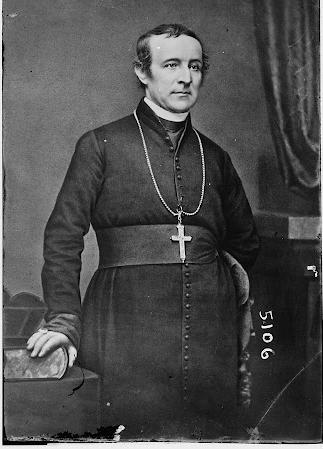
Archbishop John Hughes grew up in Ulster (Northern Ireland). Following religious and ethnic persecution there, he immigrated with his family to the United States in 1816 and was ordained a priest 10 years later in Philadelphia. He would go on to become Bishop and later Archbishop of New York.110 Archbishop Hughes is notable for his impact on New York and founding Fordham University in the Bronx.111 However, Hughes would - like England - become an advocate for neutrality.112 Hughes had long favored the assimilation of immigrants into American society - which he viewed as important for the Church’s survival in the United States.113 He may have had a valid basis, as a string of nativist attacks forced Hughes to post armed guards outside of each church in the city.114 Unfortunately, this belief also extended to the system of slavery as well. When the Daniel O’Connell-backed anti-slavery petition An Address of the People
of Ireland to their Countrymen and Countrywomen in America searched for signatories in America, Bishop Hughes actively encouraged his flock not to sign it - hoping to make as few waves as possible.115 As a prominently influential Catholic figure at the time and one of the few men with the status of Archbishop in North America, such a statement was extremely detrimental for a document almost entirely reliant on Irish Catholic support in America.116 Ultimately, the legacy of both Hughes and England was that of players at a constant game of juggling regional, Church, and moral interests in a hostile environment. Thus, the American Catholic Church would o!cially remain silent on the issue, as its two of its most influential members held this as a rule.117, 118
Conclusion
Icons opposed to slavery in the American Catholic Church were plentiful during the 18th-century periods of the Ante-Bellum and the Early Civil War eras. These forces notably included anti-slavery advocates, such as Daniel O’Connell, Bishop John Baptist Purcell, and Father Edward Purcell, in addition to the guidance of the Vatican. However, the neutralist viewpoint - one of defending the institution’s existence without supporting it - was expressed by Bishops John England, John Hughes, and others and would ultimately win. This result was due to concerns regarding the status of Catholics abroad, the Catholic Church in the U.S. wielding less political and social power than their old world counterparts, a fear of nativist backlash due to Catholic advocacy, and a variety of other factors.
One aspect not yet to be addressed in this paper is the matter of Black Catholics. Black Catholics have also existed in the U.S. since its inception - particularly in the South - and formed significant cultural and religious communities, namely in the old Louisiana territory.119 While Black Catholics were a part of each of the dioceses previously mentioned and overall a part of the broader U.S Catholic Church, they also fought against the institution of slavery in their own unique ways.
A primary example of this - albeit 100 years before the In Supremo Apostolos, Dan-
iel O’Connell, the Purcell Brothers, and the neutral Bishops- is the Stono Rebellion. This event is significant, as it marked an instance in which Black Catholic slaves organized a rebellion against their white, Protestant, English slaveowners in order to preserve their liberty, religion, and cultural traditions. The majority of these slaves - and almost the entirety of its leadership - were taken from the same African kingdom, Kongo.120 Kongo (in present-day Angola) was a fascinating nation as it was profoundly Catholic whilst never having been colonized. Catholicism represented a fundamental part of the Kongolese identity, and the Kingdom of Kongo had independent relations with the Vatican, Kongolese Catholic schools, and a relatively high literacy rate at the time.121 It is believed that leading up to the Stono revolt, the Kongolese slaves were in contact with the Catholic Spanish, who encouraged them to rise against their slaveowners and seek physical and spiritual asylum in St. Augustine.122
On the 9th day of September in the year 1739 - close to a day of Marian veneration in the Kongolese-Catholic calendar - the slave revolt began and would result in the deaths of (approximately) 30 whites and 44 slaves.123, 124 While ultimately the rebellion failed, it holds a place of importance in the struggle against slavery. Immediately evident is that this event arguably marked the most significant Catholic anti-slavery movement since De Las Casas and Encomienda. In the same breath, this movement was driven by the most overlooked Catholic population, African Catholic slaves. Unfortunately, as the Catholic population of South Carolina at the time was almost entirely African slaves whose movement was restricted and were presumably unable to interact with the broader - predominantly white - American Catholic community centered in Baltimore, it is reasonable to assume that many of the Slaves would have seen the Spanish as the only source of Catholicism on the Continent.125 Ultimately, however, this revolt, while important in its novelty, would not accomplish much due to the deaths of the plurality of the slaves involved and the complete disconnection between the rebels and the broader American Catholic community.126
Endnotes
1) ”American Catholics - Digital History.” Accessed February 21, 2024. https://www.digitalhistory.uh.edu/disp_ textbook.cfm?smtID=2&psid=2997.
2) U.S. Constitution, amend. 1.
3) “American Catholics - Digital History.” Accessed February 21, 2024. https://www.digitalhistory.uh.edu/disp_ textbook.cfm?smtID=2&psid=2997.
4) Lincoln, Mullen. 2013. “Maps of Catholic Dioceses in the US, Canada, and Mexico.” Lincoln Mullen. https:// lincolnmullen.com/blog/maps-of-catholic-dioceses-in-the-us-canada-and-mexico/.
5) 1. Julie Byrne, “Roman Catholics and Immigration in Nineteenth-Century America,” National Humanities Center, 2000, https://nationalhumanitiescenter.org/ tserve/nineteen/nkeyinfo/nromcath.htm.
6) “Nativism | Definition, Racism, Chinese Exclusion Act, Japanese-American Internment, Replacement Theory, & Facts.” n.d. Britannica. Accessed May 19, 2024. https:// www.britannica.com/topic/nativism-politics.
7) “American Catholicism,” Site Search, accessed May 20, 2024, https://pluralism.org/american-catholicism.
8) Adam, Rothman. “Georgetown University and the Business of Slavery.” Washington History 29, no. 2 (2017):
9) Kathleen. Flanagan, S.C. “The Changing Character of the American Catholic Church 1810–1850” Vincentian Heritage Journal 20, no. 1 (1999): 5.
10) John F. Quinn, “Expecting the Impossible? Abolitionist Appeals to the Irish in Antebellum America,” The New England Quarterly 82, no. 4 (2009): 709.
11) Po-chia, R. Hsia. “The Catholic Historical Review: One Hundred Years of Scholarship on Catholic Missions in the Early Modern World.” The Catholic Historical Review 101, no. 2 (2015): 225.
12) Ibid: 240.
13) Ibid: 240.
14) Francis Patrick Sullivan, Indian Freedom: The Cause of Bartolomé de Las Casas, 1484-1564: A Reader (Kansas City, MO: Sheed & Ward, 1994): 240.
15) Ibid: 240.
16) Ibid: 146.
17) Ibid: 353.
18) Po-chia, R. Hsia. “The Catholic Historical Review: One Hundred Years of Scholarship on Catholic Missions in the Early Modern World.” The Catholic Historical Review 101, no. 2 (2015): 239-240.
19) NCHE, Catholics in America, 2016, https://backstoryradio.org/wp-content/uploads/sites/12/2015/09/ Catholics-Sources.pdf.
20) “Milestones in the History of U.S. Foreign Relations - O!ce of the Historian.” n.d. History State Gov. Accessed May 19, 2024. https://history.state.gov/milestones/1750-1775/french-indian-war
21) Ibid
22) Diego, Velázquez. n.d. “Western colonialism - Spanish Empire, New World, Colonization.” Britannica. Accessed May 19, 2024. https://www.britannica.com/topic/Western-colonialism/Spains-American-empire
23) Lee, Boomer, and Eastman Johnson. 2023. “Antebellum - Women & the American Story.” Women & the American Story. https://wams.nyhistory.org/a-nation-divided/antebellum
24) Panzer, Joel S. “The Popes and Slavery: Setting the Record Straight: EWTN.” EWTN Global Catholic Television Network, 1966. https://www.ewtn.com/catholicism/library/popes-and-slavery-setting-the-recordstraight-1119.
25) Mary L, Gordon. “The Nationality of Slaves under the Early Roman Empire.” The Journal of Roman Studies 14 (1924): 111.
26) John F. Quinn, “‘Three Cheers for the Abolitionist Pope!’: American Reaction to Gregory XVI’s Condemnation of the Slave Trade, 1840-1860.” The Catholic Historical Review 90, no. 1 (2004): 79.
27) “Ethics - Slavery: Philosophers Justifying Slavery,” BBC, 2014, https://www.bbc.co.uk/ethics/slavery/ethics/ philosophers_1.shtml.
28) Paul III. Sublimis Deus. Encyclical Letter. Papal Encyclicals Online. May 29, 1537. https://www.papalencyclicals.net/paul03/p3subli.htm
29) Joel S Panzer, “The Popes and Slavery: Setting the Record Straight: EWTN,” EWTN Global Catholic Television Network, 1966, https://www.ewtn.com/catholicism/library/popes-and-slavery-setting-the-recordstraight-1119.
30) Shane O’Brien, “Why Is Daniel O’CONNELL so Revered?,” IrishCentral.com, August 6, 2022, https://www. irishcentral.com/roots/history/why-is-daniel-o-connell-so-revered.
31) Patrick M. Geoghegan, King Dan: The Rise of Daniel O’CONNELL 1775-1829 (Dublin: Gill & Macmillan, 2010). 168.
32) Britannica, T. Editors of Encyclopaedia. “Daniel O’Connell.” Encyclopedia Britannica, May 11, 2024. https://www.britannica.com/biography/Daniel-OConnell.
33) John F. Quinn, “Expecting the Impossible? Abolition-
ist Appeals to the Irish in Antebellum America,” The New England Quarterly 82, no. 4 (2009): 672.
34) John F. Quinn, “Expecting the Impossible? Abolitionist Appeals to the Irish in Antebellum America,” The New England Quarterly 82, no. 4 (2009): 697.
35) Ibid: 672
36) Fredrick Douglas , “Letter to William Lloyd Garrison (September 29, 1845),” The Gilder Lehrman Center for the Study of Slavery, Resistance, and Abolition, April 7, 2015, https://glc.yale.edu/letter-william-lloyd-garrison-september-29-1845.
37) John F. Quinn, “Expecting the Impossible? Abolitionist Appeals to the Irish in Antebellum America,” The New England Quarterly 82, no. 4 (2009): 690.
38) Ibid
39) Daniel, O’Connell. Address from the people of Ireland to their countrymen and countrywomen in America. [N. P, 1847] Pdf. https://www.loc.gov/item/11007405/.
40) QUINN, JOHN F. “Expecting the Impossible? Abolitionist Appeals to the Irish in Antebellum America.” The New England Quarterly 82, no. 4 (2009): 697.
41) Ibid: 691.
42) Ibid: 691.
43) Ibid: 692.
44) Quinn, “Expecting the Impossible? Abolitionist Appeals to the Irish in Antebellum America,” 697
45) McNamara, Robert. “Ireland’s Repeal Movement.” ThoughtCo. https://www.thoughtco.com/irelands-repeal-movement-1773847 (accessed April 3, 2024).
46) John F. Quinn, “Expecting the Impossible? Abolitionist Appeals to the Irish in Antebellum America,” The New England Quarterly 82, no. 4 (2009): 694.
47) Ibid: 693.
48) Ibid: 693.
49) Quinn “Expecting the Impossible? Abolitionist Appeals to the Irish in Antebellum America.” 694.
50) David Brundage, Irish Nationalists in America: The Politics of Exile, 1798-1998 (Oxford: Oxford University Press, 2019). 60.
51) Quinn “Expecting the Impossible? Abolitionist Appeals to the Irish in Antebellum America.” 696.
52) Ibid. 696.
53) “Political Machine,” Encyclopædia Britannica, March 22, 2024, https://www.britannica.com/topic/political-machine.
54) Satish, Joseph. “‘Long Live the Republic!’ Father Edward Purcell and the Slavery Controversy: 1861-1865.” American Catholic Studies 116, no. 4 (2005): 26.
55) Sebastian Messmer, “Archbishop ,” The Catholic Encyclopedia 1 (1907), https://doi.org/https://www.newad-
vent.org/cathen/01691a.htm.
56) “A Closer Look: The Purcell Brothers, Abolition and The Catholic Telegraph – Catholic Telegraph.” 2020. Catholic Telegraph. https://www.thecatholictelegraph. com/purcell-brothers-abolition-and-the-catholic-telegraph/70302.
57) Satish, Joseph. “‘Long Live the Republic!’ Father Edward Purcell and the Slavery Controversy: 1861-1865.” American Catholic Studies 116, no. 4 (2005): 34.
58) Ibid: 34.
59) Ibid: 34.
60) “Black History - Ohio as a Non-Slave State.” n.d. Shelby County Historical Society. Accessed April 4, 2024. https://www.shelbycountyhistory.org/schs/blackhistory/ohioasanonslave.htm.
61) Satish, Joseph. “‘Long Live the Republic!’ Father Edward Purcell and the Slavery Controversy: 1861-1865.” American Catholic Studies 116, no. 4 (2005): 34.
62) Ibid: 35.
63) “A Closer Look: The Purcell Brothers, Abolition and The Catholic Telegraph – Catholic Telegraph.” 2020. Catholic Telegraph. https://www.thecatholictelegraph. com/purcell-brothers-abolition-and-the-catholic-telegraph/70302.
64) Satish, Joseph. “‘Long Live the Republic!’ Father Edward Purcell and the Slavery Controversy: 1861-1865.” American Catholic Studies 116, no. 4 (2005): 35.
65) A Closer Look: The Purcell Brothers, Abolition and The Catholic Telegraph – Catholic Telegraph.” 2020. Catholic Telegraph. https://www.thecatholictelegraph. com/purcell-brothers-abolition-and-the-catholic-telegraph/70302.
66) Ibid.
67) Satish, Joseph. “‘Long Live the Republic!’ Father Edward Purcell and the Slavery Controversy: 1861-1865.” American Catholic Studies 116, no. 4 (2005): 36.
68) Ibid: 26.
69) Ibid: 35.
70) John F. Quinn, “‘Three Cheers for the Abolitionist Pope!’: American Reaction to Gregory XVI’s Condemnation of the Slave Trade, 1840-1860.” The Catholic Historical Review 90, no. 1 (2004): 67.
71) Ibid: 68.
72) Diana Mishkova and Balázs Trencsényi, European Regions and Boundaries: A Conceptual History (BERGHAHN Books, 2018): 126.
73) Gregory XVI. In Supremo Apostolatus. Encyclical Letter. Papal Encyclicals Online. 1839. https://www.papalencyclicals.net/greg16/g16sup.htm
74) Ibid.
75) Paul III. Sublimis Deus. Encyclical Letter. Papal Encyclicals Online. May 29, 1537. https://www.papalencyclicals.net/paul03/p3subli.htm
76) John F. Quinn, “‘Three Cheers for the Abolitionist Pope!’: American Reaction to Gregory XVI’s Condemnation of the Slave Trade, 1840-1860.” The Catholic Historical Review 90, no. 1 (2004): 86.
77) Gregory XVI. In Supremo Apostolatus. Encyclical Letter. Papal Encyclicals Online. 1839. https://www.papalencyclicals.net/greg16/g16sup.htm
78) Amanda Onion et al., “U.S. Slavery: Timeline, Figures & Abolition,” History.com, April 25, 2024, https://www. history.com/topics/black-history/slavery.
79) Gregory XVI. In Supremo Apostolatus. Encyclical Letter. Papal Encyclicals Online. 1839. https://www.papalencyclicals.net/greg16/g16sup.htm
80) James Brown, Yerrinton, and William Lloyd Garrison. “The Liberator.” Newspaper. Boston, Mass.: William Lloyd Garrison and Isaac Knapp, January 14, 1832. Digital Commonwealth, https://ark.digitalcommonwealth.org/ark:/50959/8k71pj045 (accessed May 22, 2024): 1.
81) Gregory XVI. In Supremo Apostolatus. Encyclical Letter. Papal Encyclicals Online. 1839. https://www.papalencyclicals.net/greg16/g16sup.htm
82) Ibid.
83) Ibid.
84) John F. Quinn, “‘Three Cheers for the Abolitionist Pope!’: American Reaction to Gregory XVI’s Condemnation of the Slave Trade, 1840-1860.” The Catholic Historical Review 90, no. 1 (2004): 78.
85) Ibid: 78.
86) “Act Prohibiting the Importation of Slaves,” DocsTeach, March 2, 1807, https://www.docsteach.org/documents/document/ act-prohibit-importation-slaves.
87) John F. Quinn, “‘Three Cheers for the Abolitionist Pope!’: American Reaction to Gregory XVI’s Condemnation of the Slave Trade, 1840-1860.” The Catholic Historical Review 90, no. 1 (2004): 92.
88) Ibid: 78.
89) Ibid: 81.
90) Ibid: 92.
91) Ibid: 76-77.
92) John F. Quinn. “Expecting the Impossible? Abolitionist Appeals to the Irish in Antebellum America.” The New England Quarterly 82, no. 4 (2009): 709-710.
93) John F. Quinn, “‘Three Cheers for the Abolitionist Pope!’: American Reaction to Gregory XVI’s Condemnation of the Slave Trade, 1840-1860.” The Catholic Histori-
cal Review 90, no. 1 (2004): 74.
94) Joseph, Kelly. “Charleston’s Bishop John England and American Slavery.” New Hibernia Review 5, no. 4 (2001): 49.
95) Elizabeth Stack, “Dagger John: Archbishop John Hughes and The Making of Irish America by John Loughery,” New York History 103, no. 2 (December 2022): 4.
96) Richard H. Clarke, “Lives of the Deceased Bishops of the Catholic Church in the United States, Volume 3: Clarke, Richard H. (Richard Henry), 1827-1911 : Free Download, Borrow, and Streaming,” Internet Archive, January 1, 1888: 273.
97) “Our History,” Charleston Diocese, April 30, 2024, https://charlestondiocese.org/about/our-history/.
98) John F. Quinn, “‘Three Cheers for the Abolitionist Pope!’: American Reaction to Gregory XVI’s Condemnation of the Slave Trade, 1840-1860.” The Catholic Historical Review 90, no. 1 (2004): 74.
99) Joseph, Kelly. “Charleston’s Bishop John England and American Slavery.” New Hibernia Review 5, no. 4 (2001): 49.
100) Ibid: 50
101) John F. Quinn, “‘Three Cheers for the Abolitionist Pope!’: American Reaction to Gregory XVI’s Condemnation of the Slave Trade, 1840-1860.” The Catholic Historical Review 90, no. 1 (2004): 74.
102) John F. Quinn, “Expecting the Impossible? Abolitionist Appeals to the Irish in Antebellum America,” The New England Quarterly 82, no. 4 (2009): 694.
103) John F. Quinn, “‘Three Cheers for the Abolitionist Pope!’: American Reaction to Gregory XVI’s Condemnation of the Slave Trade, 1840-1860.” The Catholic Historical Review 90, no. 1 (2004): 75.
104) “Act Prohibiting the Importation of Slaves,” DocsTeach, March 2, 1807, https://www.docsteach.org/documents/document/act-prohibit-importation-slaves.
105) John F. Quinn, “‘Three Cheers for the Abolitionist Pope!’: American Reaction to Gregory XVI’s Condemnation of the Slave Trade, 1840-1860.” The Catholic Historical Review 90, no. 1 (2004): 76-77.
106) Ibid: 78.
107) Ibid: 78-79.
108) John England and J. Murphy, “Letters of the Late Bishop England to the Hon. John Forsyth, on the Subject of Domestic Slavery, Copy 2, 1844,” Letters of the late Bishop England to the Hon. John Forsyth, on the subject of domestic slavery, copy 2, 1844 | Roman Catholic Diocese of Charleston ArchivesSpace, 1844: 1.
109) John F. Quinn, “‘Three Cheers for the Abolitionist Pope!’: American Reaction to Gregory XVI’s Condemnation of the Slave Trade, 1840-1860.” The Catholic Historical Review 90, no. 1 (2004): 78.
110) Elizabeth Stack, “Dagger John: Archbishop John Hughes and The Making of Irish America by John Loughery,” New York History 103, no. 2 (December 2022): 4.
111) Ibid: 4.
112) Satish, Joseph. “‘Long Live the Republic!’ Father Edward Purcell and the Slavery Controversy: 1861-1865.”
American Catholic Studies 116, no. 4 (2005): 26.
113) John F. Quinn, “Expecting the Impossible? Abolitionist Appeals to the Irish in Antebellum America,” The New England Quarterly 82, no. 4 (2009): 696-697.
114) Elizabeth Stack, “Dagger John: Archbishop John Hughes and The Making of Irish America by John Loughery,” New York History 103, no. 2 (December 2022): 4.
115) John F. Quinn, “Expecting the Impossible? Abolitionist Appeals to the Irish in Antebellum America,” The New England Quarterly 82, no. 4 (2009): 696-697.
116) Ibid: 697.
117) Ibid: 697-698.
118) John F. Quinn, “‘Three Cheers for the Abolitionist Pope!’: American Reaction to Gregory XVI’s Condemnation of the Slave Trade, 1840-1860.” The Catholic Histori-
cal Review 90, no. 1 (2004): 79-80.
119) “Black Catholic History Timeline,” National Black Catholic Congress Website, October 18, 2021, https://nbccongress.org/black-catholic-history-timeline/.
120) John K. Thornton. “African Dimensions of the Stono Rebellion.” The American Historical Review 96, no. 4 (1991): 1102.
121) John K. Thornton. “African Dimensions of the Stono Rebellion.” The American Historical Review 96, no. 4 (1991): 1103.
122) Mark M, Smith. “Remembering Mary, Shaping Revolt: Reconsidering the Stono Rebellion.” The Journal of Southern History 67, no. 3 (2001): 517-518.
123) Ibid: 527-528.
124) Resistance to the State, accessed May 21, 2024, https://www.lva.virginia.gov/exhibits/deathliberty/resistance/index.htm.
125) Charles H, Lippy. “Chastized by Scorpions: Christianity and Culture in Colonial South Carolina, 1669–1740.” Church History 79, no. 2 (2010): 253–254
126) Mark M, Smith. “Remembering Mary, Shaping Revolt: Reconsidering the Stono Rebellion.” The Journal of Southern History 67, no. 3 (2001): 519.
Primary Sources
Bibliography
“Act Prohibiting the Importation of Slaves.” DocsTeach, March 2, 1807. https://www.docsteach.org/ documents/document/act-prohibit-importation-slaves.
Clarke, Richard H. “Lives of the Deceased Bishops of the Catholic Church in the United States, Volume 3 : Clarke, Richard H. (Richard Henry), 1827-1911 : Free Download, Borrow, and Streaming.” Internet Archive, January 1, 1888. https://archive.org/ details/LivesOfTheDeceasedBishopsV3.
England, John, and J. Murphy. “Letters of the Late Bishop England to the Hon. John Forsyth, on the Subject of Domestic Slavery, Copy 2, 1844.” Letters of the late Bishop England to the Hon. John Forsyth, on the subject of domestic slavery, copy 2, 1844 | Ro-
man Catholic Diocese of Charleston ArchivesSpace, 1844. https://archive.charlestondiocese. org/repositories/2/archival_objects/11126.
Gregory XVI. In Supremo Apostolatus. Encyclical Letter. Papal Encyclicals Online. 1839. https://www.papalencyclicals.net/greg16/g16sup.htm
O’Connell, Daniel. Address from the people of Ireland to their countrymen and countrywomen in America. [N. P, 1847] Pdf. https://www.loc.gov/ item/11007405/.
U.S. Constitution, amend. 1.
Paul III. Sublimis Deus. Encyclical Letter. Papal Encyclicals Online. May 29, 1537. https://www.papalen-
cyclicals.net/paul03/p3subli.htm
Yerrinton, James Brown, and William Lloyd Garrison. “The Liberator.” Newspaper. Boston, Mass.: William Lloyd Garrison and Isaac Knapp, January 14, 1832. Digital Commonwealth, https://ark.digitalcommonwealth.org/ark:/50959/8k71pj045 (accessed May 22, 2024).
Secondary Sources
Journals:
QUINN, JOHN F. “Expecting the Impossible? Abolitionist Appeals to the Irish in Antebellum America.” The New England Quarterly 82, no. 4 (2009): 667–710. http://www.jstor.org/stable/25652054.
Quinn, John F. “‘Three Cheers for the Abolitionist Pope!’: American Reaction to Gregory XVI’s Condemnation of the Slave Trade, 1840-1860.” The Catholic Historical Review 90, no. 1 (2004): 67–93. http:// www.jstor.org/stable/25026521.
ROTHMAN, ADAM. “Georgetown University and the Business of Slavery.” Washington History 29, no. 2 (2017): 18–22. http://www.jstor.org/stable/90015020.
Stack, Elizabeth. “Dagger John: Archbishop John Hughes and The Making of Irish America by John Loughery.” New York History 103, no. 2 (December 2022): 420–22.
Hsia, R. Po-chia. “The Catholic Historical Review: One Hundred Years of Scholarship on Catholic Missions in the Early Modern World.” The Catholic Historical Review 101, no. 2 (2015): 223–41. http:// www.jstor.org/stable/43898525.
Gordon, Mary L. “The Nationality of Slaves under the Early Roman Empire.” The Journal of Roman Studies 14 (1924): 93–111. https://doi.org/10.2307/296326.
Joseph, Satish. “‘Long Live the Republic!’ Father Edward Purcell and the Slavery Controversy: 1861-1865.” American Catholic Studies 116, no. 4 (2005): 25–54. http://www.jstor.org/stable/44194961
Kelly, Joseph. “Charleston’s Bishop John England and American Slavery.” New Hibernia Review 5,
no. 4 (2001): 48-56. https://doi.org/10.1353/ nhr.2001.0063.
Smith, Mark M. “Remembering Mary, Shaping Revolt: Reconsidering the Stono Rebellion.” The Journal of Southern History 67, no. 3 (2001): 513–34. https://doi.org/10.2307/3070016.
Thornton, John K. “African Dimensions of the Stono Rebellion.” The American Historical Review 96, no. 4 (1991): 1101–13. https://doi.org/10.2307/2164997.
Kathleen. Flanagan, S.C. “The Changing Character of the American Catholic Church 1810–1850” Vincentian Heritage Journal 20, no. 1 (1999): 5 https:// via.library.depaul.edu/cgi/viewcontent.cgi?article=1211&context=vhj
Messmer, Sebastian. “Archbishop .” The Catholic Encyclopedia 1 (1907). https://doi.org/https://www. newadvent.org/cathen/01691a.htm.
Lippy, Charles H. “Chastized by Scorpions: Christianity and Culture in Colonial South Carolina, 1669–1740.” Church History 79, no. 2 (2010): 253–70. http://www.jstor.org/stable/27806394.
Websites:
NCHE. Catholics in America, 2016. https://backstoryradio.org/wp-content/uploads/sites/12/2015/09/ Catholics-Sources.pdf.
Panzer, Joel S. “The Popes and Slavery: Setting the Record Straight: EWTN.” EWTN Global Catholic Television Network, 1966. https://www.ewtn. com/catholicism/library/popes-and-slaverysetting-the-record-straight 1119.
“American Catholicism.” Site Search. Accessed May 20, 2024. https://pluralism.org/american-catholicism.
Mullen, Lincoln. 2013. “Maps of Catholic Dioceses in the US, Canada, and Mexico.” Lincoln Mullen. https:// lincolnmullen.com/blog/maps-of-catholic-dioceses-in-the-us-canada-and-mexico/.
Velázquez, Diego. n.d. “Western colonialism - Spanish Empire, New World, Colonization.” Britannica. Accessed May 19, 2024. https://www.britannica.
com/topic/Western-colonialism/Spains-American-empire
Boomer, Lee, and Eastman Johnson. 2023. “Antebellum - Women & the American Story.” Women and the American Story. https://wams.nyhistory. org/a-nation-divided/antebellum
“A Closer Look: The Purcell Brothers, Abolition and The Catholic Telegraph – Catholic Telegraph.” 2020. Catholic Telegraph. https://www.thecatholictelegraph.com/purcell-brothers-abolition-and-the-catholic-telegra ph/70302.
Black History - Ohio as a Non-Slave State.” n.d. Shelby County Historical Society. Accessed April 4, 2024. https://www.shelbycountyhistory.org/schs/blackhistory/ohioasanonslave.htm.
Resistance to the State. Accessed May 21, 2024. https:// www.lva.virginia.gov/exhibits/deathliberty/resistance/index.htm.
“Political Machine,” Encyclopædia Britannica, March 22, 2024, https://www.britannica.com/topic/political-machine.
“Black Catholic History Timeline.” National Black Catholic Congress Website, October 18, 2021. https:// nbccongress.org/black-catholic-history-timeline/.
Onion , Amanda, Missy Sullivan, Matt Mullen, and Christian Zapata. “U.S. Slavery: Timeline, Figures & Abolition.” History.com, April 25, 2024. https:// www.history.com/topics/black-history/slavery.
“Our History.” Charleston Diocese, April 30, 2024. https:// charlestondiocese.org/about/our-history/.
Britannica, T. Editors of Encyclopaedia. “Daniel O’Connell.” Encyclopedia
Britannica, May 11, 2024. https://www.britannica.com/ biography/Daniel-OConnell.
O’Brien, Shane. “Why Is Daniel O’Connell so Revered?” IrishCentral.com, August 6, 2022. https://www. irishcentral.com/roots/history/why-is-danielo-connell-so-revered.
Byrne, Julie. “Roman Catholics and Immigration in Nineteenth-Century America.” National Humanities Center, 2000. https://nationalhumanitiescenter. org/tserve/nineteen/nkeyinfo/nromcath.htm.
Books:
Geoghegan, Patrick M. King Dan: The rise of daniel O’CONNELL 1775-1829. Dublin: Gill & Macmillan, 2010. Pg. 168
Sullivan, Francis Patrick. Indian freedom: The cause of Bartolomé de las Casas, 1484-1564: A reader. Kansas City, MO: Sheed & Ward, 1994.
Mishkova, Diana, and Balázs Trencsényi. European regions and boundaries: A conceptual history. BERGHAHN Books, 2018.
Brundage, David. Irish nationalists in America: The politics of exile, 1798-1998. Oxford: Oxford University Press, 2019.

China’s Migrant Workers and the Curse of Hukou
Will Days ‘27
When labor issues in China come to mind, most people think about things like underage workers or unsafe working conditions,1 but one of the most significant labor issues in China today concerns the treatment of internal migrant workers. This paper deals primarily with migrant workers, explaining why a particular economic reform is needed to ensure that they are treated fairly, and outlining how better treatment of migrant workers will improve China’s economy in the 21st century.
Before the economic reforms of 1978, China’s economy was based on agriculture and was designed to make sure the country produced enough food to feed its citizens. Over the next three decades, China’s economy began to open, and it experienced a rapid transformation from the agrarian economy of the 1950s and 1960s to an economy based on manufacturing, construction, and service industries.# “Labor reforms helped China to undergo a structural change from a predominantly agrarian to a modern industrial and service economy, as well as a systemic change from a planned to a market economy.”3 To power this new economy, approximately 300 million internal migrant workers have moved from rural areas to the cities to work, hoping to make a better life for their families.4 These migrant workers are often poorly paid, have few rights or benefits, and often work in dangerous conditions.5 “In dangerous industries such as mining, chemical engineering, or firework production, more than half of the employees are rural residents.”6 Migrant workers’ “cheap wages helped China become the world’s biggest manufacturer and made the country’s megacities hum.”7 But even though they power China’s new economy, migrant workers are second-class citizens because of hukou, China’s residential registration system. The current hukou system was established in 1958 and is designed to: (1) distribute
government welfare and resources; (2) control internal migration; and (3) allow for the criminal surveillance of residents.8 Each city and town issues its own hukou and is responsible for providing municipal services, like health insurance and school for children, only to local hukou holders.9 Hukou also carries a central classification - either rural or urban - and is hereditary, so people cannot easily switch from one hukou to another.10 “The system enshrines and indeed perpetuates China’s sharp urban-rural divide and inter-provincial inequalities. And because hukou status is often inherited, the children of itinerant workers typically lack access to public education where they live. Almost 70 percent of Chinese children have rural hukou.”11 Migrant workers are often uneducated, with 55.4% leaving school after middle school and another 14.7% leaving after primary school.12

Significantly, when the current hukou system was established, China’s economy was based almost entirely on agriculture and one of the main things hukou was designed to do was to keep workers in rural areas to provide the food the country needed.13 Unfortunately, today, Chinese migrant workers are second-class citizens because most of them still hold rural hukou. This means that they do not have the same rights or opportunities as urban hukou holders. They have no living wage, no health insurance in the cities where they live and work, no pension, city schools will not accept their children, and it is almost impossible
for rural hukou holders to own property in urban areas. They are discriminated against in all areas of their lives.14 “Chinese companies routinely shortchange their employees on wages, withhold health benefits and expose their workers to dangerous machinery and harmful chemicals, like lead, cadmium and mercury.”15 Many of them do not even have access to their own employment contracts and have no way of fighting back against poor treatment in the workplace.16 This makes them second-class citizens—similar in some ways to undocumented immigrants in the United States.17 hukou disproportionately harms rural people,18 and creates “a peculiar local urbanization and development pattern which segregates migrants from local residents, excludes migrants from local welfare, imposes a strict surveillance system on migrants, and discriminates against migrants as second class citizens who only have temporary household resident status. Without “rights in the city,” Chinese migrant worker’s subjugation to global capital becomes not only a “class” issue but also a “citizenship” issue.”19 Improving labor conditions in China, particularly those related to migrant workers, requires the true economic reform of current hukou restrictions that have been in place all over China since 1958, when the country’s economy was radically di erent from what it is today.
One of the most di!cult choices migrant workers face when they decide to move from rural China to the cities to look for work is whether or not they should bring their children with them when they move.20 Some migrant workers choose to leave their children behind with their families in the rural areas, and others take their children with them to the cities. Either way, the children su er. “There are about 70 million left-behind children in China, and they experience many e ects of poverty. . .many children in China are mentally and physically ill, don’t receive a proper education, and are essentially stuck in the cycle of poverty.” 21 If they are home with their rural family (often grandparents or other elderly relatives), they can go to school but often live in extreme poverty with relatives who are older and don’t have the money or energy to care for them.22 Most left-behind children aren’t
even able to stay in school because they must work on the farm to help their families survive, leaving them no time for school.23 On the other hand, if children move with their parents to the city, they have no healthcare and are not allowed to go to state run schools because their family does not have urban hukou 24 Some migrant workers pay illegal extra fees to send their children to state schools, but many cannot a ord this.25 As of 2022, approximately 1.13 million primary school age migrant children and about 481,000 middle school age migrant children did not attend public schools.26 While some attend schools specifically for migrant children, these schools typically have poor facilities and less qualified teachers.27 In 2020, only 2.39% of students who took university entrance exams were migrant children.28 Lack of education among migrant children perpetuates the cycle of poverty, locks these children out of better paying job opportunities that require more education, and essentially prevents them from obtaining urban hukou.
The story of Fang TianTian clearly illustrates this problem. In the early 1990s, Fang was left behind by her parents in the poor region of Guizhou, grew up with her elderly grandparents, and was mostly left to raise herself.29 Twenty years later, she made the same choice with her own daughter.30 She explains that she and her husband felt that they had no choice but to leave their daughter behind because Shanghai, where they found jobs, has very strict hukou laws.31 No one can get Shanghai hukou unless they meet at least one of four guidelines: (1) a strong educational background; (2) a significant investment in Shanghai; (3) transfer a work permit (pay taxes for 5-7 years); and/or (4) hold international education credentials.32 Fang and her husband do not meet any of these criteria and knew that they would be unable to provide their child with basic services like healthcare and schooling if she had moved with them.33 Fang tried to justify her decision, saying that her daughter’s life is typical of a child living in Guizhou.34 “Almost everyone in my beauty shop was raised by their grandparents,” says Fang. “And all of our children are now being cared for by our parents back home.”35 Many of these children “su er severe psychological damage.
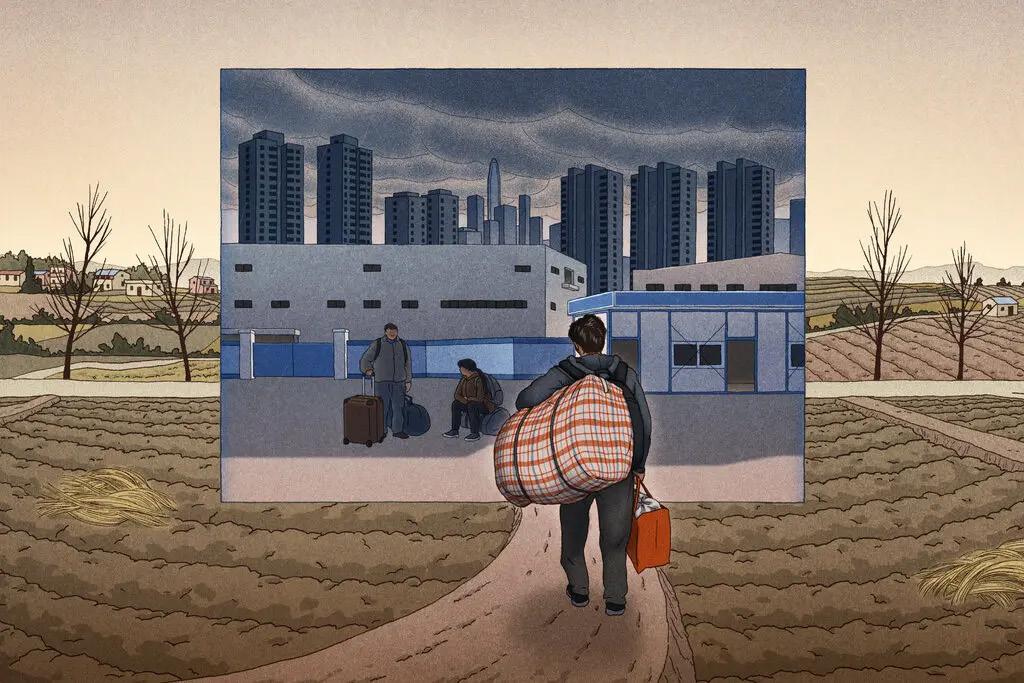
Their emotional states are significantly more negative on average than other children, and they find it much harder to communicate.”36 Understandably, they often grow to resent their parents for leaving them. Older migrant workers also struggle. As they age, less educated migrant workers often have trouble finding work and take on temporary work or extremely low-paying, di!cult jobs that no one else wants.37 The story of Duan Shuangzhu illustrates this struggle. Duan Shuangzhu moved from Shanxi province in northern China, where his former job was raising sheep and cows,38 to Beijing, where he has lived for the last 25 years, earning only 3,300 yuan a month ($460), collecting trash beginning at 3:00 am every day. He sends most of his earnings to his wife, who is taking care of their grandchildren and living on their farm in Shanxi.39 At age 68, Duan has no pension and no plans to quit until he is physically unable to collect trash anymore.40 In 2022, 85 million migrant workers were over age 50 (29% of all migrant workers), and 75% of them will work long past age 65.41 “Now that times are tough and
jobs harder to find, China’s roughly 300 million migrant workers, with flimsy social benefits, have little to fall back on. They don’t enjoy the same health insurance, unemployment, and retirement benefits as city-born people, as threadbare as their safety net is. Once migrant workers pass their prime working age, they are expected to go back to their home villages so they won’t become burdens to the cities.”42 Nearly all migrant workers “feel trapped because the absence of economic opportunity in the countryside makes it impossible to return home; yet in their new home, they are cut o from even fundamental welfare benefits, thus increasing their vulnerability and dependence on their employers.”43 China is going to continue to have these issues if they don’t fix the current hukou system.
Today, the Chinese urban labor market is divided into two di erent segments, low end service industry or manufacturing/factory jobs and highly skilled technical jobs. “The former mainly [seeks] young rural-to-urban migrants, and the latter searche[s] mostly for holders of superior academic credentials.”44 In 2020, with
a declining and rapidly aging population,45 China’s central government decided that some regions should start to relax hukou for certain workers, primarily young, highly educated university graduates.46 In January 2022, China’s National Development and Reform Commission relaxed hukou rules to further encourage urbanization. Essentially, it ordered that cities with populations under 3 million will have hukou limits removed and, in cities with populations between 3 and 5 million, hukou rules will be eased.47 At first glance, it seems like China is moving in the right direction, but a closer look shows us that these changes really didn’t mean much at all. For most poor, uneducated, rural migrant workers, it remains almost impossible to become an urban hukou holder.48 Many of the “reforms” don’t do anything to help most regular migrants as they are unable to meet the stringent, locally-set criteria required to become an urban hukou holder.49 There are several reasons for this. First, while the central government says it wants to help all Chinese people reach their “Chinese dreams,”50 in reality, Xi Jinping cares more about social stability. “While hukou reforms o er policymakers some options for boosting the nation’s economic growth in the long term, the importance of maintaining social stability in the coming months will outweigh any such considerations. Not only could radical reforms be a potentially destabilizing force in general, but they would also specifically alienate the vested interests in maintaining current hukou policies (namely top o!cials and middle- and upper-class residents of China’s tier-one cities) at a time when Xi cannot a ord to risk antago-
nizing such elites.”51 Second, meaningful hukou reform requires buy-in not only from China’s central government but also from local o!cials, something that is far from guaranteed because local governments do not want to pay for migrants’ health insurance, pensions, or schooling for their children, people they can currently ignore.52 Under the current system, it is to the cities’ advantage to continue to limit the number of local urban hukou holders.
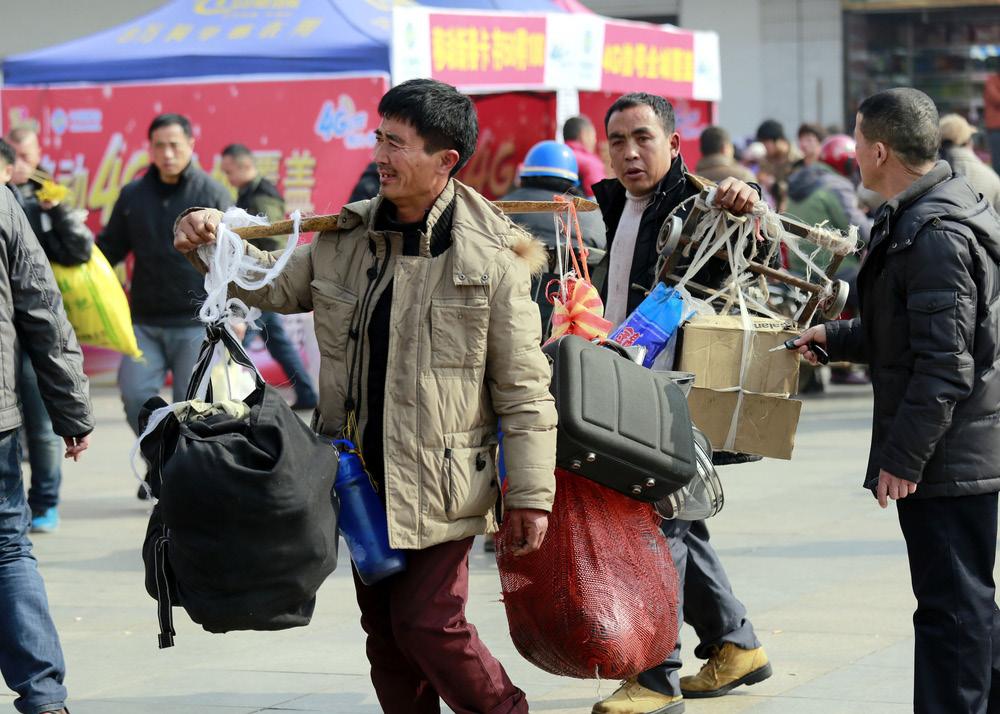
Today, the main reasons that hukou was established in 1958 are no longer relevant. China’s economy is no longer agrarian and no longer relies exclusively on food from rural China to feed its population. Today, China’s economy is based on manufacturing, construction, and service industry jobs and requires hundreds of millions of workers in its cities, both skilled and unskilled. As it stands now, however, hukou is hurting generations of families because they are tied to rural areas where there is no longer any opportunity for them to succeed financially, educationally, or otherwise. Those with rural hukou have no savings, no pensions, no medical care and no education, so they don’t spend what little money they have, instead saving it for emergencies.53 If they choose to live and work in the cities, they do so as second-class citizens.54 For these reasons, China needs to gradually lift hukou, in a controlled and planned mannerregion by region - for all residents. Lifting hukou this way will allow for the creation of a true national labor market, while also removing the burden that migrants place on local municipal government. “Increased urbanization, which goes hand in hand with the easing of hukou re-
strictions, allows all urbanites to access social services and welfare which in turn aids this new consumer-driven economy as household capital is freed up. Furthermore, with increased consumer purchasing power, living standards are raised.”55 In 2024, China’s premier proposed providing urban residency to the 300 million migrant workers who hold rural hukou, noting that giving them the same rights as urban hukou holders will benefit the Chinese economy “as they represent a vast pool of potential investment and spending.”56 Notably, sustainable hukou reform also requires political, fiscal, and tax reforms.57
There is no doubt that reforming hukou will be a slow and complex undertaking, requiring buy-in from both Xi Jinping’s leadership team and local city governments, but the long-term benefits are clear: lifting hukou will allow families to stay together, give more Chi-
nese children access to quality education (and thus better jobs in the future), o er migrant workers more control over where they live, empower them in their workplaces, and allow them to participate more fully in the economy, thus powering China into the 21st century.
Endnotes
1) Christopher Smith and Sherrod Brown, “Working Conditions And Worker Rights In China: Recent Developments,” USC Annenberg, last modified July 31, 2012, https://china.usc.edu/calendar/working-conditions-and-worker-rights-china-recent-developments.
2) “Migrant workers and their children,” China Labour Bulletin, last modified September 6, 2023, https://clb. org.hk/en/content/migrant-workers-and-their-children.
3) David Pong, Encyclopedia of Modern China (Farmington Hills, MI: Charles Scribner’s Sons/Gale Cengage Learning, 2009), [Page 410]
4) Li Yuan, “They Propelled China’s Rise. Now They Have Nothing to Fall Back On.,” NY Times, last modified November 1, 2023, accessed May 16, 2024, https://www. nytimes.com/2023/11/01/business/china-rural-jobs-migrant-workers.html.
5) Julia Greene, “The Condition of the Working Class in Shenzhen,” Dissent, https://www.dissentmagazine. org/article/condition-working-class-shenzhen-peasant-workers-authoritarian-consumer ism/.
6) Pong, Encyclopedia of Modern, [Page 410].
7) Yuan, “They Propelled,” NY Times.
8) “Migrant workers,” China Labour Bulletin.
9) Ferdinand A. Gul and Haitian Lu, “Population and Employment,” in Truths and Half Truths: China’s Socioeconomic Reforms from 1978-2010 (2011), [Pages 1-31], accessed May 18, 2024, https://www.sciencedirect.
com/topics/social-sciences/hukou#:~:text=Under%20 China’s%20hukou%20system%2C% 20each,within%20 a%20specific%20administrative%20unit.
10) “Migrant workers,” China Labour Bulletin.
11) Henry Storey, “Is China finally getting serious about hukou reform?,” theinterpreter, last modified September 7, 2023, https://www.lowyinstitute.org/the-interpreter/china-finally-getting-serious-about-hukou-reform.
12) “Migrant workers,” China Labour Bulletin.
13) Keith Lamb, “When it comes to China’s development, Hukou reform is inevitable,” China Daily, last modified July 18, 2022, https://global.chinadaily.com. cn/a/202207/18/WS62d4b01ea310fd2b29e6cd7b.html.
14) Greene, “The Condition.”
15) David Barboza, “In Chinese Factories, Lost Fingers and Low Pay,” The New York Times (New York City, United states), January 5, 2008, https://www.nytimes. com/2008/01/05/business/worldbusiness/05sweatshop. html.
16) Greene, “The Condition”.
17) Ibid
18) Anik Guha, “The Hukou System, Migrant Workers, & State Power in the People’s Republic of China,” Northwestern Journal of International Human Rights 3, no. 1 (2005): [Page 2], https://scholarlycommons.law.northwestern.edu/cgi/viewcontent.cgi?article=1014&context=njihr.
19) Kaxton Siu, Chinese Migrant Workers and Employer Domination : Comparisons with Hong Kong and Vietnam (Singapore: Palgrave Macmillan, 2020), [Page 5].
20 ) “Migrant workers,” China Labour Bulletin.
21) Radley Tan, “China’s Left-Behind Children,” The Borgen Project (blog), entry posted October 19, 2020, accessed May 18, 2024, https://borgenproject.org/ left-behind-children/#:~:text=Left%2Dbehind%20children%20are%20much,worsen%20m ental%20and%20 physical%20health.
22) “Migrant workers,” China Labour Bulletin. 23) Tan, “China’s Left-Behind,” The Borgen Project (blog).
24) “Migrant workers,” China Labour Bulletin.
25 ) Yuanfei Li and Zhongshan Yue, “Migrant Children’s Schooling in Urban China,” N-IUSSP, December 7, 2020, accessed May 18, 2024, https://www.niussp.org/ migration-and-foreigners/migrant-childrens-schooling-in-urban-chinascolarite-des-enfants-m igrants-enchine-urbaine/.
26) “Migrant workers,” China Labour Bulletin.
27) Li and Yue, “Migrant Children’s.”
28) Ibid
29) Fan Yiying and Qin Siqi, “China’s Left-Behind Kids Repeat Their Parents’ Tragic Choices,” Sixth Tone, last modified January 18, 2021, https://www.sixthtone.com/ news/1006704.
30) Ibid
31) Ibid
32) Ibid
33) Ibid
34) Ibid
35) Ibid
36) Ibid
37) Ken Moritsugu, “Migrant workers who helped build modern China have scant or no pensions, and can’t retire,” apnews, last modified March 29, 2024, https://apnews.com/article/china-migrant-worker-economy-f9dc355c514 cedf3b79d9d3a840ee6.
38) Ibid
39) Ibid
40) Ibid
41) Ibid
42) Yuan, “They Propelled,” NY Times.
4) 3 Greene, “The Condition.”
44) William Hurst, The Chinese Worker after Socialism (Cambridge: Cambridge University Press, 2009), eBook Collection (EBSCOhost).
45) Arendse Huld, “China’s Changing Labor Market –Trends and Future Outlook,” China Briefing, last modified April 19, 2023, https://www.china-briefing.com/ news/chinas-labor-force-data-trends-and-future-outlook/.
46) “Migrant workers,” China Labour Bulletin.
47) Lamb, “When it comes,” China Daily.
48) Eduardo Jaramillo, “China’s Hukou Reform in 2022: Do They Mean it this Time?,” CSIS (blog), entry posted April 20, 2022, https://www.csis.org/blogs/new-perspectives-asia/chinas-hukou-reform-2022-do-theymean-it-time-0.
49) Recent Chinese Hukou Reforms, H.R. Rep. (). https:// www.cecc.gov/recent-chinese-hukou-reforms.
50) “Workers’ rights and labour relations in China,” China Labour Bulletin, last modified July 10, 2023, https://clb.org.hk/en/content/workers%E2%80%99-rights-and-labour-relations-china.
51) Jaramillo, “China’s Hukou,” CSIS (blog).
52) Ibid
53) Storey, “Is China,” theinterpreter.
54) Greene, “The Condition.”
55) Lamb, “When it comes,” China Daily.
56) Mandy Zuo, “China’s ‘two sessions’ 2024: long-awaited reform for 300 million migrants could open wellspring of demand,” South China Morning Post, March 6, 2024, accessed May 18, 2024, https://www.scmp.com/ economy/china-economy/article/3254361/chinas-twosessions-2024-long-awaited-reform-30 0-million-migrants-could-open-wellspring-demand.
57) Storey, “Is China,” theinterpreter.
Bibliography
Barboza, David. “In Chinese Factories, Lost Fingers and Low Pay.” The New York Times (New York City, United states), January 5, 2008. https://www.nytimes. com/2008/01/05/business/worldbusiness/05sweatshop. html.
Greene, Julia. “The Condition of the Working Class in Shenzhen.” Dissent, Fall 2018. Accessed May 18, 2024. https://www.dissentmagazine.org/article/condition-working-class-shenzhen-peasant-work ers-authoritarian-consumerism/.
Guha, Anik. “The Hukou System, Migrant Workers, &
State Power in the People’s Republic of China.” Northwestern Journal of International Human Rights 3, no. 1 (2005). https://scholarlycommons.law.northwestern. edu/cgi/viewcontent.cgi?article=1014&conte xt=njihr.
Ferdinand A., and Haitian Lu. “Population and Employment.” In Truths and Half Truths: China’s Socioeconomic Reforms from 1978-2010, 1-31. 2011. Accessed May 18, 2024. https://www.sciencedirect.com/topics/social-sciences/hukou#:~:text=Under%20China’s% 20hukou%20 system%2C%20each,within%20a%20specific%20administrative%20unit.
Huld, Arendse. “China’s Changing Labor Market –Trends and Future Outlook.” China Briefing. Last modified April 19, 2023. https://www.china-briefing.com/news/chinas-laborforce-data-trends-and-future-outlook/.
Jaramillo, Eduardo. “China’s Hukou Reform in 2022: Do They Mean it this Time?” CSIS (blog). Entry posted April 20, 2022.
https://www.csis.org/blogs/new-perspectives-asia/chinas-hukou-reform-2022-do-they-me an-it-time-0.
Lamb, Keith. “When it comes to China’s development, Hukou reform is inevitable.” China Daily, July 18, 2022, global edition.
Li, Yuanfei, and Zhongshan Yue. “Migrant Children’s Schooling in Urban China.” N-IUSSP, December 7, 2020. Accessed May 18, 2024. https://www.niussp.org/ migration-and-foreigners/migrant-childrens-schooling-in-urban-c hinascolarite-des-enfants-migrants-en-chine-urbaine/.
“Migrant workers and their children.” China Labour Bulletin. Last modified September 6, 2023. https://clb. org.hk/en/content/migrant-workers-and-their-children.
Moritsugu, Ken. “Migrant workers who helped build modern China have scant or no pensions, and can’t retire.” AP News (Beijing, China), March 29, 2024. Accessed May 18, 2024. https://apnews.com/article/china-migrant-worker-economy-f9dc355c514 cedf3b79d9d3a 840ee6.
Pong, David. Encyclopedia of Modern China. Farmington Hills, MI: Charles Scribner’s Sons/Gale Cengage Learning, 2009.
Recent Chinese Hukou Reforms, H.R. Rep. (). https:// www.cecc.gov/recent-chinese-hukou-reforms.
Siu, Kaxton. Chinese Migrant Workers and Employer Domination : Comparisons with Hong Kong and Vietnam. Singapore: Palgrave Macmillan, 2020. This book talks about the issues that employees have
Smith, Christopher, and Sherrod Brown. “Working Conditions And Worker Rights In China: Recent Developments.” USC Annenberg. Last modified July 31, 2012. https://china.usc.edu/calendar/working-conditions-and-worker-rights-china-recent-develo pments.
Storey, Henry. “Is China finally getting serious about hukou reform?” theinterpreter. Last modified September 7, 2023. Accessed May 18, 2024. https://www.lowyinstitute.org/the-interpreter/china-finally-getting-serious-about-hukou-r eform.
Tan, Radley. “China’s Left-Behind Children.” The Bor-
gen Project (blog). Entry posted October 19, 2020. Accessed May 18, 2024. https://borgenproject.org/ left-behind-children/#:~:text=Left%2Dbehind%20children%20a re%20much,worsen%20mental%20and%20 physical%20health.
William Hurst. The Chinese Worker after Socialism. Cambridge: Cambridge University Press, 2009. eBook Collection (EBSCOhost).
“Workers’ rights and labour relations in China.” China Labour Bulletin. Last modified July 10, 2023. https://clb.org.hk/en/content/workers%E2%80%99-rights-and-labour-relations-china.
Yiying, Fan, and Qin Siqi. “China’s Left-Behind Kids Repeat Their Parents’ Tragic Choices.” Sixth Tone. Last modified January 18, 2021. https://www.sixthtone.com/ news/1006704.
Yuan, Li. “They Propelled China’s Rise. Now They Have Nothing to Fall Back On.” New York Times (Hong Kong), November 1, 2023, The New New World. Accessed May 16, 2024. https://www.nytimes.com/2023/11/01/business/china-rural-jobs-migrant-workers.html.
Zuo, Mandy. “China’s ‘two sessions’ 2024: long-awaited reform for 300 million migrants could open wellspring of demand.” South China Morning Post (Hong Kong), March 6, 2024. Accessed May 18, 2024. https://www. scmp.com/economy/china-economy/article/3254361/ chinas-two-sessions-20 24-long-awaited-reform-300million-migrants-could-open-wellspring-demand.

The Chinese Holocaust: The Rape of Nanjing Lessons
Riley Marth ‘27
Nanjing, December, 1937
Poem by Wing Tek Lum
“Thousand of tethered like cattle, herded like sheep
Into the mountains, the suburbs, the city squares
Into the gullies, and the waterfront,
To be skewered like pigs, mounted from behind like goats, Castrated, pummeled senseless, clubbed to death,
To be buried alive in ditches dug by themselves, Buried to their waists, their guts ripped out like dogs,
To be run over by tanks, drowned in the river without pity, Doused with acid, sprayed with gasoline, and then set on fire, Locked in their homes which were set on fire,
To be propped up for bayonet drills, Hung by their tongues to wooden boards,
To be mutilated, their faces pieces with needles,
Ears hacked o , their eyes gouged out, Slivers of skin carved o , stripped by thin strips, Pensies cleaved o to be dried and consumed,
To be assembled to be machine gunned Or blown up with hand grenades, Or one by one shot in the back by the side of the road,
To be stabbed, disemboweled, dismembered, To be shoved into icy ponds, their frozen corpses
Like floating logs used for target practice, Row upon row to be force to kneel upon the shore
And then decapitated by swords thrust into necks, Severing flesh, crushing bone, their heads flying o Torso sporting twin foundations of blood, Crumpling into the mud, only to be dumped into the river By the next row of men ready to take their places. And then it was the women’s turn.”1
The Nanjing Massacre, also known as the Rape of Nanjing, was the inhumane Japanese violent aggression victimizing Chinese persons, that took place over a six-week period starting on December 13, 1937, the day the Japanese marched into Nanjing, to early February 1938, during the second Sino-Japanese War which preceded World War 2.2 Due to the unthinkable nature of the barbarisms that occurred, it has been characterized as the “Chinese Holocaust”.3 The Nanjing atrocities included the systematic murder of hundreds of thousands of powerless vulnerable Chinese Prisoners of War (POWs) and innocent Chinese civilians by burning victims alive, decapitation, and other horrendous means, looting, and arson.4 The brutality was further compounded by the raping of an estimated twenty to eighty thousand Chinese woman and girls by Japanese soldiers.5 Several factors and conditions led to the causation of these war crimes committed by the Japanese Imperial Army (JIA).6 These factors consisted of the Japanese culture at the time impacting the mindset of the Japanese soldiers involved, the delusional military policy that terrorizing the Chinese people would show the superiority and prowess of Japan, and extremely poor decisions by the upper echelons of the JIA. This “defective decision-making process” created perverse conditions exacerbating the flames of the perpetrated terror7: the inability of Japanese commanders and inexperienced soldiers to handle the vast amount of captured Chinese soldiers and citizens,8 the strict adherence to orders given by the superiors in the Japanese military leading to the subsequent dehumanization of the POWs and Chinese civilians by the Japanese soldiers, the ignoring of numerous precedents and warning signs of these atrocities on both Chinese and Japanese soil, and finally, during and leading up to the massacre, there were a wide range of responses, from complicity to active encouragement, by Japanese high command and field o!cers to carry
out these atrocities. These factors and conditions collided together igniting one of the most horrifying events in the 20th century.
During the Nanjing Atrocities, after the orders were given from the Japanese leaders to execute the POWs due in part because they didn’t know what to do with the captured, since there were so many who surrendered as the killing went on, the radical field o!cers encouraged the soldiers to kill in ever more “inventive” (psychopathic) ways. This is exemplified by the mass decapitation using the soldiers’ katanas, only meant to be decoration accessories to their uniforms.9 In addition, one account claims the soldiers’ hung victims by their tongues before killing them.10 Furthermore, due to the massive amounts of victims killed and dumped into the Yangtze River, multiple accounts claim the river ran red with blood. 11 The Japanese soldiers rounded up anyone suspected of being a Chinese soldier, basically, all able-bodied men and boys, took them out to the countryside, divided them in groups of 200, brought them to “a suitable place,” and murdered them in mass under the aforementioned command, of the higher-ups12, a direct violation of the 1893 Hague Treaty that protects prisoners of war, which Japan had signed,
as well as the Geneva Convention 13. Meanwhile, in Nanjing itself, the Japanese soldiers killed sporadically, “lashing out” at Chinese civilians, and as Rev. John Magee, a Christian missionary, westerner, and witness to the atrocities, stated, “Many of them were shot down like hunting rabbits in the street.”14 This demonstrates how little JIA valued Chinese lives. The Chinese were thought of as “subhuman.”15 On top of all these crimes, the Japanese soldiers raped between 20,000 to 80,000 women between the age of 10 and 60 years old, and even pregnant women. 16. They murdered the children or siblings of these women who were considered “in the way.” 17 Many of the women were subsequently stabbed to death and mutilated. 18 The Japanese soldiers justified these murders by saying they “didn’t want to leave any evidence.” 19 Others were kidnapped, taken to the Japanese barracks, and forced into becoming “comfort women.” which was a euphemism for sex slave. 20 These “comfort women” were repeatedly raped in addition to being forced to clean and cook for their abusers, as if to rub salt in the wound. 21 There is vast evidence on the myriad of atrocities that occurred at the Massacre of Nanjing, from eyewitness and victim reports, diaries, and letters, 22and the Magee Film,

taken by Rev. Magee, who secretly filmed the atrocities with his 16 mm camera.23

The Nanjing Atrocities were the result of Japan’s military culture of strictly following orders given by higher-ups, the rise of radical views on the superiority of Japan’s “minzoku” (volk), and the resulting dehumanization of Chinese POWs and civilians. During the Taisho period, around the 1920s, the army su ered a decline in discipline24. This decline caused the o!cers to demand strict discipline after the Taisho period and severely punished those who stepped out of line, often using “inhumane methods.”25 In addition, many of the soldiers in China were inexperienced reservists due to the high replacement rate caused by heavy casualties.26 The Japanese su ered significant losses in Shanghai on the way to Nanjing, so many in fact that historians dubbed it as the “Chinese Stalingrad.”27 These factors led to the Japanese soldiers lashing out at Chinese civilians due to the trauma received from these “inhumane punishments” and as an act of gruesome revenge for the men they lost. Many of the perpetrators of these crimes, on later reflection, blamed the military’s culture of strictly following orders. Though this could be seen as a dubious source, yet it is telling of Japan’s strict hierarchical culture.28 The Japanese term which directly translates to the Three ALLs Policy (‘’KILL ALL, BURN ALL, and LOOT ALL.”), was a JIA slogan that the Japanese soldiers claimed two decades later that dictated their actions when they admitted to these atrocities in 1957. 29 Around the Taisho period, JIA started permitting 14-year-old boys into their army as it was easier to indoctrinate them. 30 The younger o!cers were, the more “inhumane punishments’’ they perpetrated due to the indoctrination into Ultra-Nationalist beliefs with the idea of the Japanese “racial purity,” similar to that of the Nazis.31 This idea, that Japanese were somehow superior to the Chinese or any other “race”, could be traced back to the 1870s and grew substantially in popularity after Japan’s victory over the Tsar’s Russia in 1895 and during the Meiji Restoration, a period of rapid technological development in Japan.32 This rapid modernization was used by these Ultra-Nationalists to justify their view on the
superiority of the Japanese race or “minzoku” and its place as the “Asian leader.” The “inferiority” of the Chinese was outlined in Nakamura’s Nations of the Far East, which divided the world into five races: yellow, black, white, and dark.33 This book was similar to Ernst Haeckel’s Riddle of The Universe, which grouped people into races and ranked them. Nakamura’s book conveyed the Nazi idea that certain races were active or “historical races” (white and yellow), and the rest were “passive.”34 The term “minzoku” was coined by Nakamura, which he drew from the English word, nation, and the German concept of “volk”. “Volk” became central in the Nazi worldview. 35Further exacerbating the soldiers mindset of superiority, the Japanese military ran on the mythicized Bushido code that, among other things, claimed surrendering was “the ultimate act of cowardice and disgrace,”36 evidenced by the fact that many Japanese soldiers took their own lives rather than surrender during World War 2. This belief caused the Japanese soldiers to abhor the surrendering Chinese soldiers, adding another way to dehumanize them and another layer away from their universe of obligation. It is ironic that the Bushido (honor) code actually prohibited many of the crimes committed by the Japanese in Nanjing, but that wasn’t called into question by the JIA leaders at the time.37 The Nanjing atrocities were the outcome of the cancerous Ultra-Nationalistic and abusive culture of the Japanese military, and o!cer corps, that was the volatile fuel only needing a spark, a trigger, an order, to burst into a terrifying inferno of mass murder and genocide. There were numerous incidents that were ignored or endorsed by the Japanese, which resulted in the Nanjing Atrocities. The first of which was the flare of anti-Chinese and Korean violence that erupted after a magnitude 7.8 earthquake hit Japan (Great Kanto Earthquake) that, as well as the ensuing fires, killed 150,000 people and made 600,000 homeless. 38 Newspapers spread false rumors that the Koreans and Chinese ethnic minorities in Japan were poisoning the water and sabotaging businesses, similar to the false propaganda circulated by the Nazis about the Jews.39 These rumors led to what is best described as a Korean-Chi-
nese pogrom that led to the deaths of 2,600 Koreans and 150 to 170 Chinese people before martial law was declared by the Japanese government. 40Instead of reevaluating what led to this pogrom and educating the people on the incorrectness of these rumors, they used it as an excuse to arrest political dissenters such as an Anarchist figure, Osugi Sakai, who had nothing to do with the pogrom.41 Later, during the Shanghai campaign on the road to Nanjing, there were articles in Japanese papers reporting on a “contest to kill 100”, entitled “Contest to Kill 100 Goes Over the Top” 42 and “Contest to cut down a hundred! Two-second lieutenants are already up to 80,” 43 These articles glorified a contest between these fanatic field o!cers. They describe not how many people they could kill in battle, but how many POWs they could kill. The proper name of this “contest’’ should have been the “Barbaric Mass Murder of Prisoners Contest.” 44 The newspaper article reads like a sports column and lauds these soldiers for these repugnant acts as “‘heroism.’’45 These articles reveal how these horrific acts and the soldier’s mindset were acclaimed as the prowess of Japan during this time. In one of the articles, they interviewed one of these “contestants” who openly brags about his war crimes boasting, “With things going like this I’ll probably cut down a hundred by the time we reach Danyang, never mind Nanjing. You’re going to lose. My sword has killed 55 and only has a little nick on it.”46 Clearly, the string of systematic murders of Chinese POWs and civilians didn’t begin at Nanjing and was prevalent throughout the entirety of the Shanghai Campaign.47 These warning signs were ignored, and as in the case of a few instances like the aforementioned articles, they were actively encouraged to continue to carry out these crimes and lauded as heroes for doing so.
Before and during the atrocities, most of the Japanese high command and field o!cers were either complicit or fanatically encouraging and ordering their soldiers to carry out these crimes. In fact, Japan’s Army School’s (equivalent to West Point) textbook said there would be no punishments for killing prisoners.48 This is in direct contradiction to the Hague Treaty. On August 5th, the Emperor of
Japan gave an o!cial order to refer to the Chinese POWs as “prisoners not POWs”49, adding a layer of deniability of their actions against the Chinese POWs if their actions came under scrutiny. Another violation of the Hague Treaty. Furthermore, the mass executions of the POWs were given by those above the ranks of the radical field o!cers.
One such example was when a field officer, Lt. Cho, ordered indiscriminate fire on a crowd of several Chinese civilians. When his Japanese soldiers hesitated, Lt Cho screamed, ““This is how you kill people!,” drew his sword, and killed some of his soldiers... Shocked, the other soldiers opened fire.” 50 Moreover, the Japanese also mismanaged the POWs, due to the mere volume of them explained in Lt. Nakajima diary. They did not have the space, nor the supplies, such as food for themselves let alone the captured, and there was concern of possible uprising.51 These conditions combined with the Japanese disdain for those who surrendered, led to many of the commanders ordering mass Chinese executions. This was exemplified, on the outskirts of Nanjing on December 18th, 1937 when, a lower field commander called his superior o!cer, Lt. Colonel Cho Isamu, questioning, “We have 12,000 or 13,000 Chinese penned up here. What do we do with them?” the Lt. Colonel retorted “Be done with it. I’ll clean up later” 52. This was a direct deliberate order to exterminate those Chinese POWs. This order resulted in the murder of all of them.53 In the city, the Japanese commanders, in a rush to take Nanjing, had forgotten to make the correct supply preparations, leading to a significant breakdown in the supply chain.54 However, they remembered to bring along lorries and a su!cient amount of ammunition to secure and transport their loot, so this may have been an intentional move.55 Though not the cause of the Nanjing Atrocities, the lack of supplies did exacerbate and contributed to the looting and burning of every home that wasn’t in the Nanjing Safety Zone, a 1.5mile zone of protection established by an international committee. It was established for the foreigners and Chinese who didn’t leave before the Japanese occupation.56 Also, General Matsui, a Japanese commander who was supposed
to oversee the city’s takeover, was the only Japanese leader to condemn and show remorse for the Japanese’s actions and had issued orders to prevent his soldiers from abusing the Chinese civilians.57 Unfortunately, he fell ill and was replaced by Prince Asaka, the uncle of the emperor, who was complicit and later went on to deny the massacre and blame it on those who ranked below him58. But, Matsui’s subordinates disobeyed his orders previously in Shanghai, raping and pillaging all the same, so it may have made little to no di erence.59 Other sources claim Matsui took part in the looting and rape, making o with Nanjing’s priceless art.60 The complicity or active role in the Nanjing Atrocities and their ill-advised decisions created the perfect spark and gave the oxygen needed for the horror to continue.
The Nanjing atrocities were the result of the perfect fire storm. It was the outcome of the sentiments and biases of the perpetrators, the Japanese, that created the highly combustible fuel that only needed the right spark to start an inferno. In this case, there were multiple sparks that were ignored, or actively fanned and in addition to just the right spark created by the failures and active encouragement and complicity of the Japanese military leaders,
provided the oxygen needed to ignite the sixweek inferno.
How do we prevent horrific events like this from happening in the future? We don’t allow these biases and sentiments to grow and create the fuel. While there may always be cultural bias between Chinese and Japanese people, e orts can be made to prevent them from growing out of control like what happened in Japan in the early 1900s through education on these atrocities and empathy training. Another way to prevent these atrocities from occuring in the future is to pay attention to any warning signs and respond to them, both as global citizens and as citizens of our own countries. Finally, we don’t vote for, or support, those who would make these mistakes, not bothering to bring enough supplies, not anticipating the large influx of prisoners after they took Nanjing, and who are complicit or hold such intense hatreds to enter the military or be leaders in government. If attainable, these measures will help quell the fires of hatred and prevent these horrible atrocities from repeating themselves.
Endnotes
1) Wing Tek Lum, The Nanjing Massacre : Poems (n.p.: Bamboo Ridge Press, 2013)
2) New World Encyclopedia, accessed May 17, 2024, https://www.newworldencyclopedia.org/entry/Nanjing_Massacre.
3) Maddison Whipple, “The Infamous Nanjing Massacre: Here’s What Happened,” The Collector, February 17, 2024, accessed May 16, 2024, https://www.thecollector. com/destruction-of-nanjing.
4) Memories of the 1937 Nanjing Massacre (San Francisco, CA: Sinomedia International Group, Long River Press, 2017)
5) Captivating History Writers, The Rape of Nanking : the Nanjiang Massacre That Occurred during the Second Sino-Japanese War (Place of publication not identified: Captivating History, 2021),
6) Katsuichi Honda, Frank Gibney, and Karen Sandness, The Nanjing Massacre : a Japanese Journalist Confronts Japan’s National Shame (London [England]: Routledge,
2015)
7) Richard C. Bush, “Thoughts on the Nanjing Massacre,” Brookings Institute (Washington DC, USA), December 1, 2007,, accessed May 16, 2024, https://www.brookings. edu/articles/thoughts-on-the-nanjing-massacre/.
8) Whipple, “The Infamous,”
9) Captivating History Writers, The Rape, 10) Benjamin Lai and Giuseppe Rava, Shanghai and Nanjing 1937 : Massacre on the Yangtze (Oxford: Osprey Publishing, 2017)
11) Captivating History Writers, The Rape, 12) Honda, Gibney, and Sandness, The Nanjing
13) Captivating History Writers, The Rape,
14) Captivating History Writers, The Rape, 15) Whipple, “The Infamous,” 16) Ibid
17) Captivating History Writers, The Rape, 18) Ibid
19)
20)Ibid
21) Memories of the 1937 22) Ibid
23) Captivating History Writers, The Rape
24) Bush, “Thoughts on the Nanjing,”
25) Ibid
26) Whipple, “The Infamous,”
27) Captivating History Writers, The Rape,
28) Ibid
29) Ibid
30) Ibid
31) Facing History and Ourselves Editors, The Nanjing Atrocities : Crimes of War (Brookline, MA: Facing History and Ourselves, 2014)
32) Ibid
33) Facing History and Ourselves Editors, The Nanjing, 3
34) Ibid
35) Ibid
36) Whipple, “The Infamous,”
37) Honda, Gibney, and Sandness, The Nanjing
38) Facing History and Ourselves Editors, The Nanjing, 39) Facing History and Ourselves Editors, The Nanjing, 40) Ibid
41) Ibid
42) Captivating History Writers, The Rape, 43) Honda, Gibney, and Sandness, The Nanjing 44) Ibid
45) Captivating History Writers, The Rape, 46) Honda, Gibney, and Sandness, The Nanjing
47) Captivating History Writers, The Rape, 48) Honda, Gibney, and Sandness, The Nanjing 49) Ibid
50) Ibid
51) Ibid
52) Honda, Gibney, and Sandness, The Nanjing 53) Ibid
54) Captivating History Writers, The Rape
55) Ibid
56) Whipple, “The Infamous, 57) Captivating History Writers, The Rape
58) Marry Margaret Penrose, “War Crimes,” ed. Encyclopedia Britannica Editors, Encyclopedia Britannica, last modified March 29, 2024, accessed May 16, 2024, https:// www.britannica.com/topic/war-crime.
59) Captivating History Writers, The Rape 60) Penrose, “War Crimes,” Encyclopedia Britannica.
Bibliography
Bush, Richard C. “Thoughts on the Nanjing Massacre.” Brookings Institute (Washington DC, USA), December 1, 2007. Accessed May 16, 2024. https://www.brookings. edu/articles/thoughts-on-the-nanjing-massacre/.
Captivating History Writers. The Rape of Nanking : the Nanjiang Massacre That Occurred during the Second Sino-Japanese War. Place of publication not identified: Captivating History, 2021.a
Facing History and Ourselves Editors. The Nanjing Atrocities : Crimes of War. Brookline, MA: Facing History and Ourselves, 2014.
History.com Editors. “Rape of Nanjing: Massacre, Facts and Aftermath.” History.com. Last modified August 11, 2023.
https://www.history.com/topics/asian-history/nanjing-massacre.
Honda, Katsuichi, Frank Gibney, and Karen Sandness. The Nanjing Massacre : a Japanese Journalist Confronts Japan’s National Shame.
London [England]: Routledge, 2015. Lai, Benjamin, and Giuseppe Rava. Shanghai and Nanjing 1937 : Massacre on the Yangtze. Oxford: Osprey Publishing, 2017.
Lum, Wing Tek. The Nanjing Massacre : Poems. N.p.: Bamboo Ridge Press, 2013. New World Encyclopedia. Accessed May 17, 2024. https://www.newworldencyclopedia.org/entry/Nanjing_Massacre.
Penrose, Marry Margaret. “War Crimes.” Edited by Encyclopedia Britannica Editors. Encyclopedia Britannica. Last modified March 29, 2024. Accessed May 16, 2024. https://www.britannica.com/topic/war-crime. Tokyo Tribunals.
Whipple, Maddison. “The Infamous Nanjing Massacre: Here’s What Happened.” The Collector, February 17, 2024. Accessed May 16, 2024. https://www.thecollector. com/destruction-of-nanjing.
Memories of the 1937 Nanjing Massacre. San Francisco, CA: Sinomedia International Group, Long River Press, 2017.
2024 Presidential Election
Ben Adams ‘25, Christopher McEvoy ‘25
With the 2024 presidential election quickly approaching, The Podium decided to send out a poll to gauge how the Belmont Hill community feels about it. One hundred eightyfive members of Belmont Hill’s student body, faculty, and sta responded.
The first question asks who everybody will/would vote for. The most popular choice was Harris and Walz at 54.1%, followed by Trump and Vance at 34.6%. This di ers strongly
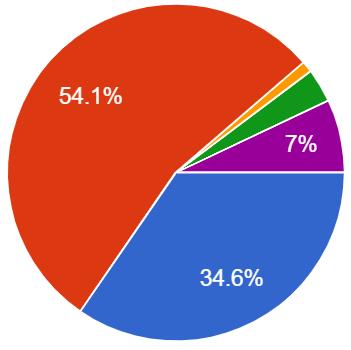




Question 1: Who will/would you vote for in the 2024 presidential election?
from the outcome of the election. The national averages showed 48.4% voting for Harris and Walz and 50.0% voting for Trump and Vance. The nation views Trump and Vance much more favorably than the Belmont Hill community and Harris and Walz slightly less favorably. The community was also asked how they would feel about the outlook of the nation if either candidate was elected. If Trump were elected, only 26.5% of the community would be optimistic about the country’s future, while only 27.6% would feel optimistic if Harris was elected. This is concerning as 34.6% of people said they were voting for Trump, and 54.1% of people said they were voting for Harris/ Walz. This means that the Belmont Hill community overall is not optimistic about the Nation with either candidate and that a significant portion voted for the “less bad” candidate.
The poll also asked how/if Biden drop-
ping out of the race a ected their vote. 76.8% of people said that it did not a ect their vote, and the second highest response, with 13%, said that they went from undecided to Harris. This question was posed to see how the community

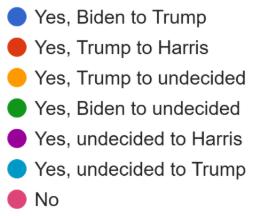
Question 4: Did Biden’s drop-out from the race change your intended vote?
felt about Biden compared to Harris. Only 3.2% of people went from either undecided /supporting Biden to Trump, and 16.8% went from either undecided/supporting Trump to Harris. This shows that the Belmont Hill community generally finds Kamala Harris to be a better candidate than Biden.
This idea of a relatively high percentage of the community (13%) going from undecided to Harris is further supported by the next question the form asked about how everyone would rate their political a!liation. 29.7% re-
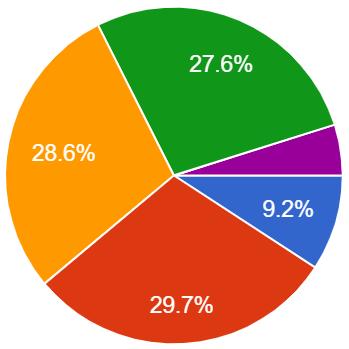

Question 5: How would you describe your political a!liation?
sponded as center left, followed by center moderate at 28.6%, then 27.6% center right, 9.2% far left, and finally 4.9% far right. This is compared to the results of Harris and Trump. It seems that those who identify as moderate more strongly supported Harris this year as the gap in the president was larger than the political identity gap of right versus left.
place votes. The remaining five issues ended up being relatively evenly distributed without consensus picks for fourth through eighth place.
The next question posed in the survey asked where people were receiving the majority of their election news. The results of this question were relatively varied, but certain trends ap-
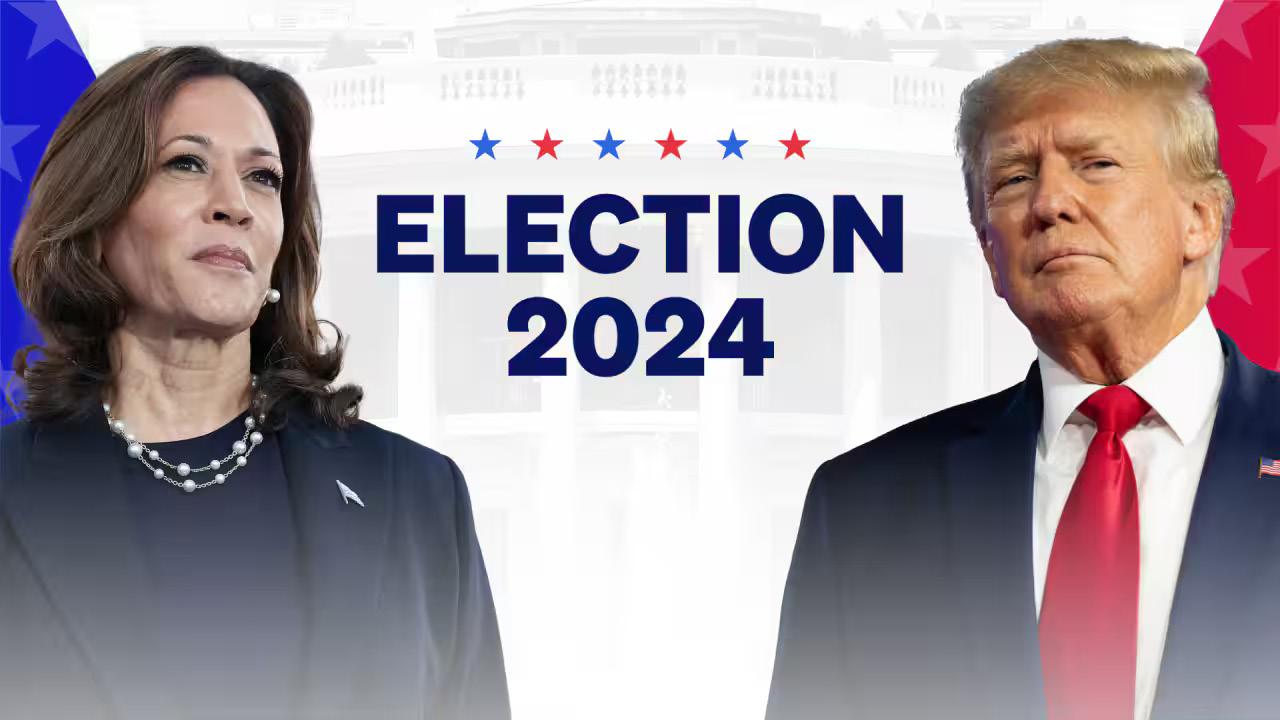
The next question of the survey asked people to rank the most important issues in the upcoming election from their perspective. The issues that were put forward included the economy/inflation, reproductive rights, healthcare, immigration, gun rights, foreign a airs, climate change, and civil rights. The issue that, without a doubt, was the most important for our student body was the economy/inflation. 76 of the 185 responses had the economy/inflation as the number one most important issue leading up to the election. Consensus’s second most important issue seems to be immigration, with eighteen responses being the most important issue and thirty-six responses being the second most important issue. The third most important issue seemed pretty clearly to be foreign a airs, with a pretty even distribution of first, second, and third-
peared in the responses. Social media was a consistent answer reflecting the modern conveying of news in our society. There was also a large presence of people getting their news from more traditional large-scale news networks such as ABC, CNN, Fox, and NBC, among others. Classic newspapers also made significant appearances in the survey results. For example, the New York Times and The Wall Street Journal headlined such newspapers. Arguably, a worrying trend did appear in the data, which was the shocking number of responses that conveyed that people had received no election news whatsoever.
Kamala Harris marked the third vice president to run for president while they were currently serving in o!ce as vice president. Throughout the campaign process, Kamala Harris was criticized by both the right for perceived failures of

| Data Analysis
The
the Biden-Harris Administration and praised by the left for successes of the Biden-Harris


this election was going to play a major role in the future of most Americans. In response to this assertion, we proposed the question of asking people to rank on a scale of one to five, five being a lot and one being not at all. How much would this election a ect their lives, in their opinion? There was a tie between three and four, with 31.4% of people putting down a four and 31.4% of people putting down a three. This demonstrated that the majority of students believed the election would have a relatively significant impact on their lives, if not a major impact.
Administration. Due to this trend, we asked in the survey whether students held Vice President Harris responsible for the policies of the Biden administration. This question received very split results, with 56.8% of people saying that they did not hold Vice President Harris responsible for the policies of the Biden Administration and 43.2% of people saying that they did hold Vice President Harris responsible for the policies of the Biden administration. Across the vast majority of news sources leading up to the election, it seemed as though
The initial presidential debate between former President Trump and sitting President Joe Biden back in June played a major role in the election leading soon after to president by dropping out of the presidential race. A second presidential debate was held in September between Vice President Harris and former president Trump. We asked the school whether the debate between Vice President Harris and former President Trump a ected who they would vote for. The result was incredibly lopsided, with 82.2% of people surveyed saying that the presidential debate did not change who they were going to vote for. Only 7% of people said that it did change who they were going to vote

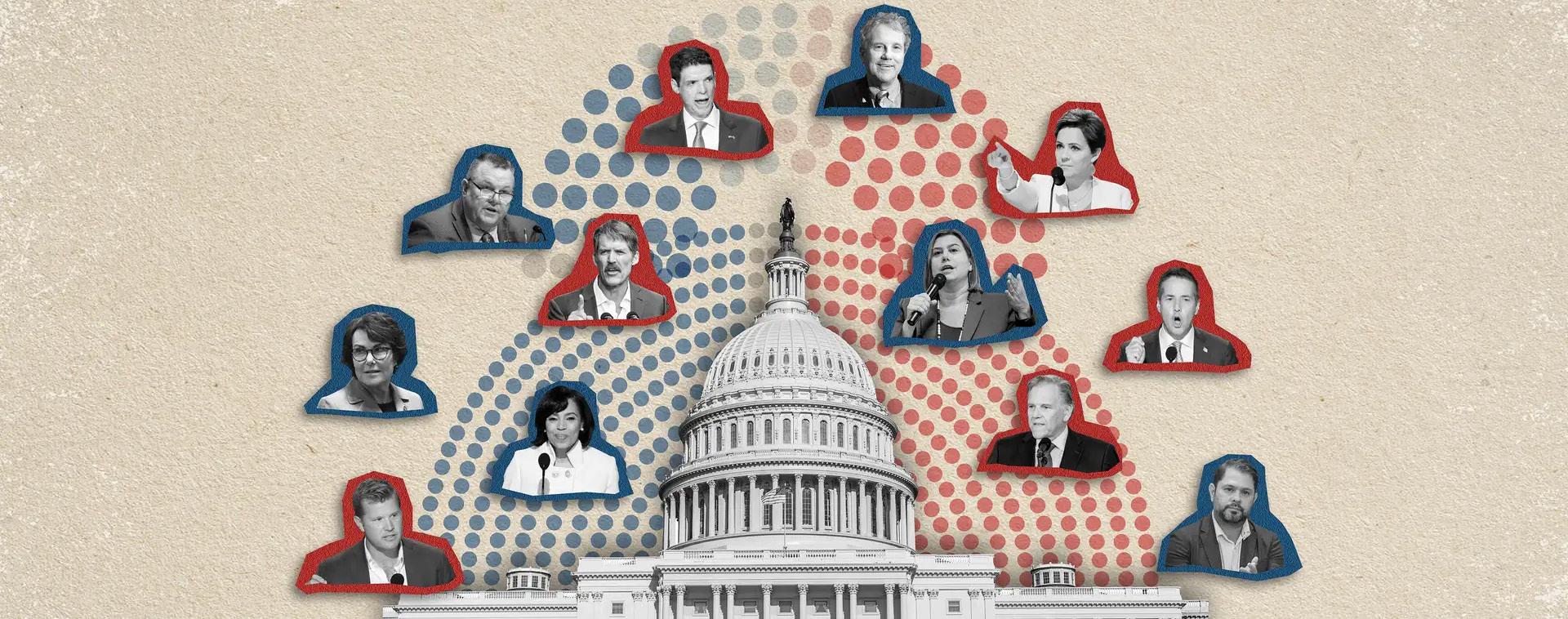
for, with the remaining people saying that they did not watch the debate at all.
This year’s election is not just for the president but also includes every member of the House of Representatives and a third of the current US Senate. Therefore, we pose the question of whether the candidate that people supported for president was of the same party as the candidate they supported for other offices, such as the Senate and the House of Representatives. This question received incredibly mixed results, with the majority of people saying that yes, they supported all Democrats; however, this majority had only 32.4% of the vote. Another 29.2% of people said that the question was either unable or that they were unsure. 17.3% said that they supported all Republicans in the House, Senate, and the White House. 13.5% of people said that they’d supported the Democratic candidate for the presidency but would support Republican candidates for the Senate or House of Representatives. Final-
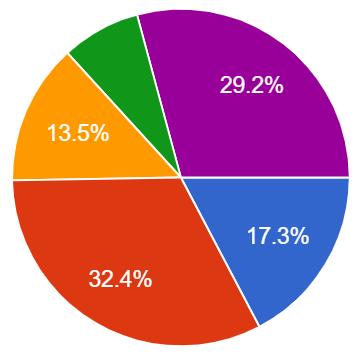
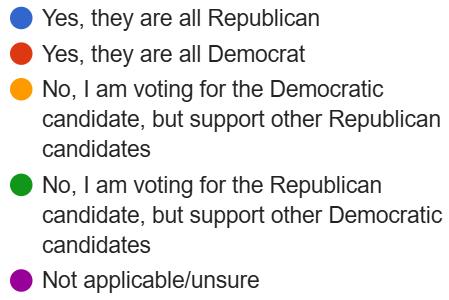
Question 8: Is your choice for President of the same party as your choice for other candidates running for the House of Representatives and Senate?
ly, only 7.6% of people said that they supported a Republican for president but a Democrat for Senate or House of Representatives. Despite the relatively mixed results, the response generally portrayed a student body and faculty that was partisan in who they voted for for office.
The final question posed in the survey asked students to rank one to five what they believed the most important quality was in a presidential candidate. The qualities o ered were policy issues, the view of them by other world leaders, Leadership style and ability, personal identity and attributes, and their ability to work with others. The most important quality for a presidential candidate, according to the Belmont Hill Community, was policy issues. The second most important quality was leadership style and ability. The consensus was that the least important quality of a presidential candidate was their personal identity. Overall, support for each candidate is largely divided within the Belmont Hill community. With the election fast approaching, it will be interesting to see who will lead our country for the next 4 years, and how their decisions will a ect us as a nation.
House and Senate Races
Suhas Kaniyar ‘28
The 2024 Elections have paved the way for a transformative era for Congress, setting the stage for new legislative priorities under President-Elect Donald J. Trump. The Republican Party regained control of the Senate and retained a thin lead in the House, significantly altering the political landscape on Capitol Hill. This article aims to provide insight into both chambers’ significant changes, their impact, and the high-profile races that led to the outcome.
The Republican Party regained a majority in the United States Senate for the first time since 2016. Prior to the elections, Democrats held on to a slim lead of one seat, which was undone by three crucial Republican victories that pushed them past the majority qualification. In West Virginia, Glenn Elliot (D) ran due to the retirement of Joe Manchin (D), which allowed Jim Justice (R) to have a relatively peaceful path to the seat, winning nearly 70% of the vote. Jim Justice will be the first Republican to represent West Virginia since Chapman Rivercomb in 1959. In Ohio, businessman Bernie Moreno (R) beat incumbent Senator Sherrod Brown (D) 50.2% to 46.4% in a shocking upset. The race ended up totaling the most expensive Senate race of the year, with over $500 million poured into campaign advertisements, travel, etc. Associating closely with Joe Biden and Kamala Harris led many voters to perceive him as “too liberal for Ohio.” Moreno will be the first Latino to represent Ohio in the Senate and plans to align himself with Trump’s political agenda. Brown’s loss marks the end of a Democrat-
ic stronghold in Ohio, reflecting shifting voter values. Lastly, Tim Sheehy (R) overtook threeterm veteran Jon Tester (D) in Montana with 52.6% of the vote.
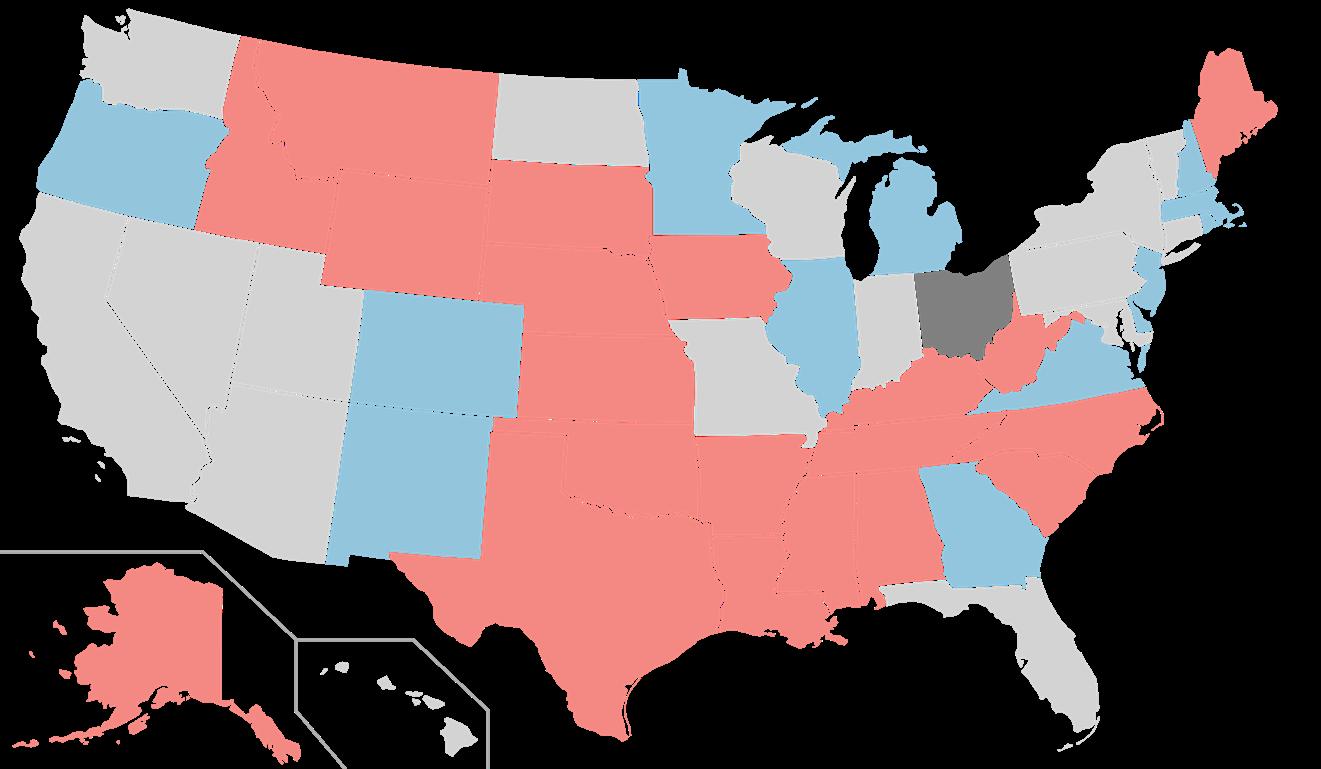
Map of Senate Election
Additionally, Republicans carried this momentum in two races previously thought of as close, Colin Alred (D) against Ted Cruz (R) and Debbie Mucarsel-Powell (D) against Rick Scott (R), and eventually won decisively, with Allred capturing 44% of the vote and Mucarsel-Powell a 42.6%. However, Democratic Senators won 4 of the 5 Presidential swing states, all of which Trump won, with Tammy Baldwin winning 49.6% and Elissa Slotkin winning 48.6%. The main factors attributed to Democratic success in these states’ Senate Elections (compared to Presidential Elections) are individual candidate appeal, incumbency advantage, personal connection, and campaign strategy. For example, in Wisconsin, Tammy Baldwin did much better than Kamala Harris, who lost by 300,000 votes. Baldwin, a Wisconsin native, simply had more connection to the state. Due to this, she focused on pertinent issues to the locals, such as healthcare a ordability. Another example is Arizona, a state where, despite Trump’s 200,000 votes more than Harris, Ruben Gallego (D) won with 50.1%, more than 80,00 votes more than Kari Lake (R). Many accredit this loss to personal appeal; according to political scientist Larry Sabato, Lake has an “arrogance that turns people o .” Contrary to recent media, the fact that these states alternated parties between each election shows that the people are not simply voting for a party, but for a candidate. Despite su ering disappointing Senate losses, the Democratic Party is hopeful for successful 2026 campaigns. Senate
control will ease President-Elect Donald J. Trump’s path to successfully electing his Cabinet and other government o!cials and help him enact laws. However, his success will be limited by the slim margins and division of the Senate Republicans.
The House did not change much, with Republicans retaining a thin lead. The Republicans’ 220 seats, two over the 218 majority threshold and six over the Democrats, allowed the party to maintain a slim but essential lead. Despite disappointing losses in the Senate, Democrats went on to win two seats in the House, narrowing the Republican lead. Marrianette Miller-Meeks (R) overtook Christian Bohannan (D) with 50.1% to 49.9% in Iowa’s First Congressional District. This marks the second time she has won in a recount in three elections, showcasing how competitive the area is. Another exciting race was California’s 45th, in which Derek Tran (D) ended Michele Steel’s (R) twoterm stint. Both were Asian-American candidates who kept an anti-China focus. In addition, they kept their ethnicity as a big part of their campaigns, with the most significant demographic in the region being Asian Americans, consisting of 39% of California’s 45th. The race was one of the most expensive of the year, totaling $46 million, and reflected the high stakes of the region. In Washington’s third district, Marie Gluesenkamp Perez (D), a moderate Democrat, defeated Joe Kent (R) in a majority Republican region. Joe Kent not only had the backing of Mike Johnson, but Steve Scalise
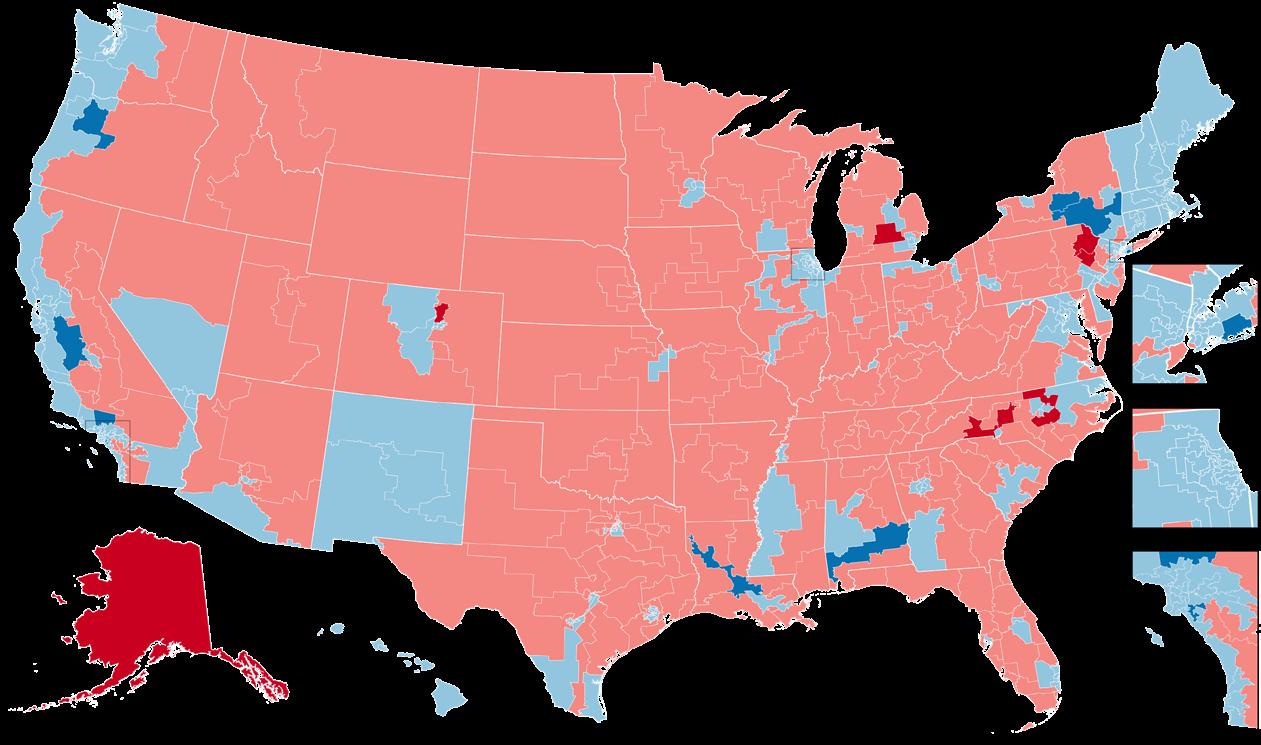
and Donald J. Trump helped him fundraise and campaign. Initially thought of as neck and neck, this race was the most significant margin of victory at the time, with Perez winning with over 16,000 votes. After a major upset in 2022, taking a seat that Republicans had held for a decade, she will head back to o!ce for a second term. Out of all 435 House Seats, one is yet to be finalized: CA-13, Adam Gray (D) vs. John Duarte (R), in which both candidates are at 50%. Gray currently has 104,991 votes, with Duarte trailing at 104,801, a mere di erence of 190 votes! Mike Johnson (R), representative since 2017, will continue to serve as Speaker of the House alongside Majority Leader Steve Scalise, representative since 2008. Hakeem Jeffries, who made history as the first Black lawmaker to lead a party in Congress, will continue representing the Minority Democrats. Overall, House control secures the Republican Party’s unification throughout the chambers and will allow Republicans to pass new legislation. With the conclusion of the 2024 House and Senate races, the landscape of Congress has taken a massive pivot. The Republican Party will be able to pass laws more e!ciently, with unification across both chambers and the presidency. Despite this, Trump will rely on almost every Republican seat, due to thin leads in both chambers. These elections marked a turning point in Congress, with the changes made undoubtedly promoting the political agenda of President-elect Donald J. Trump.

A Refutation Against the Illegality of Israeli Settlements
Eli Norden ‘26
The issue of Israeli settlements in Judea and Samaria/the West Bank is not at the forefront of the minds of most involved or interested in current global a airs. However, to understand the history of the Israeli-Palestine and regional Israeli-Arab conflict, the ongoing war, and the prospects of peace, it is crucial to understand international law and its relation to Israeli Settlements. The West Bank is divided into three Areas: A, B, and C, covering 18%, 22%, and 60% respectively.
Area A is administered solely by the Pal-

estinian Authority (PA). Responsibility for Area B’s civil control is the PA’s, whereas Israeli and Palestinian security forces share security responsibilities. Area C is Israeli-administered and contains all Israeli settlements. Demographically, Jews constitute a slight 51.9% majority in Jerusalem, whereas Palestinians make up 85.2% of the West Bank’s population. As of 2020, 451,700 Israeli Jews were living in Judea and Samaria, and 230,000 in East Jerusalem. In both locations, the Israeli government does not exercise sovereignty. 20-30,000 Israelis live in outposts deemed illegal by Israeli law. Onethird of this population is Ultra-Orthodox, onethird Orthodox, and one-third secular. Despite the many problems with the current Israeli Settlement movement, the argument that Israeli settlements are illegal under international law is largely baseless, as the main pieces of legislation used against Israeli settlements are misinterpreted.
Before any argument can be made about the legality of Israeli settlement, it is necessary to establish how international law operates in this case. Article 42 of Treaty IV of the 1907 Hague Convention established the precedent that “Territory is considered occupied when it is actually placed under the authority of the hostile army.” The definition is extended to include an “unconsented-to e ective control over a territory to which it has no sovereign [italics added] title.” The West Bank raises a particularly interesting question, as a fully sovereign Palestinian state has never existed there. Israel, however, legally occupied the territory following the Defensive Six-Day War in 1967. Israel does, in fact, have a sovereign title to the territory. Besides the Jordanian Annexation of the West Bank from 1949-1967, when the Jewish population was kicked out of Judea, Samaria, and Jerusalem, Jews have maintained a continuous presence in the region since Biblical times. Stating that the Jews have no claim to sovereignty over any territory in the land of
Israel is not only factually incorrect, it’s antisemitic. Perhaps Israel has the greatest claim to sovereignty over the land.
The Fourth Geneva Convention in 1949 dealt with humanitarian issues and protections for non-combatants and is the underlying text for the anti-settlement argument. Article 49 reads, “The Occupying Power shall not deport or transfer parts of its own civilian population into the territory it occupies.” No Israeli government has ever transferred any part of its civilian population into occupied territories. Vladimir Putin’s Russia is the prime example of an occupation breaking international law; Putin declared Crimea to be a sovereign territory, barring “foreign citizens” (including Ukrainians) from owning land, as per Russian Law. Six years after Russia’s annexation of Crimea in 2014, Russian settlers constituted a larger part of the Crimean population than Israeli settlers in the West Bank after 53 years of settlement. Israeli settlements anger global leaders and media more than the mass movement of Russians into Crimea, representing an anti-Israel bias. While the Israeli government does o er financial incentives, such as free transportation to and from school for families with young children and some deductions on income and corporate taxes, decreasing the cost of living enough to entice Israelis to move to this land, the government has never directly moved citizens living in Israel proper to territory in Judea, Samaria, or East Jerusalem, and has thus never violated Article 49.
Certain UN resolutions are recommendatory, and their sometimes-vague language leaves room for interpretation that the word of the resolution does not o er. Resolution 242, passed by a 15-0 vote in the United Nations Security Council (SC) in 1967, established a framework to navigate to aftermath of the Six-Day-War in which Israel occupied Egypt’s Sinai Peninsula (withdrew 1982), the Gaza Strip (withdrew 2005), the Golan Heights (annexed 1981), and the Jordanian West Bank after swiftly defeating the invading Egyptian, Jordanian, and Syrian armies. The resolution condemns the acquisition of territory by war and most notably calls for a “withdrawal of Israel armed forces from territories occupied in the recent
conflict.” This Resolution doesn’t equate the withdrawal of Israeli forces from the territory gained in 1967 to the creation of a sovereign Palestinian state, and it directly contradicts Article 80 of the UN Charter. Chapter VI of the United Nations charter, the manner by which 242 was passed, allows the SC to o er recommendations; the SC does not have the power to enforce their resolutions. Chapter VI Resolutions are recognized as political expressions, not obligations. For example, Azerbaijan still occupies the Nagorno-Karabakh region despite multiple UN resolutions, having displaced almost all Ethnic Armenians since 2023.
Legal principles and the founding document of the UN also support Israeli settlements, despite the body’s obsession with them. Uti Possidetis Juris is a customary international law that serves to establish the boundaries of decolonized territories. Historian Eugene Kontorovich explained that, in accordance with Oslo and the 2008 peace attempt, “Israel’s borders are those of the Palestine Mandate that preceded it, except where otherwise agreed upon by Israel and its relevant neighbor.” The British Mandate for Palestine included the Gaza Strip and Judea/Samaria. Uti Possidetis Juris applies in the Holy Land, and Israeli settlements are thus legal under international law. Article 80 of the United Nations Charter a!rms that Jews are allowed to live in all parts of their ancestral homeland. Technically, the so-called “Jewish Clause” allows for Jews to live in Gaza, the West Bank, the Golan, and East Jerusalem. Article 80 of the United Nations enshrines the Jews’ legal right to live in their ancestral homeland. Denying the Jews access to their religious sites and ancient land is antisemitism. This can’t be done while infringing on Palestinians’ rights, as well.
The settler movement and Israeli farright have turned into a violent and somewhat Jewish supremacist ideology, dehumanizing Palestinians and ignoring their human rights. Israel must make concessions for peace, and the movement must undergo massive reform if it hopes to see any increase in international–or national–support. According to a June 2024 Pew Research study, 85% of Orthodox and Ultra-Orthodox Jews believe that settlements help Israeli security, alongside 68% of the ideo-
logical right, mainly composed of orthodox and ultra-orthodox. Only 26% of the Jewish ideological center and left agree. Recently, the 2022 Religious Zionist-Likud coalition deal vaguely supports annexing the West Bank, and states that “the Jewish people have the exclusive and indisputable right to all [italics added] parts of the Land of Israel.” At the same time, the Netanyahu government chose peace with the UAE and Bahrain in 2020 over Israeli sovereignty over certain West Bank settlements. According to projections, ultra-orthodox Haredim will comprise 1/3 of the Israeli-Jewish population by 2060, meaning that non-Haredi Jews will compromise a plurality slightly under half of the total Israeli population. Support for settlements will naturally increase as the Haredi population booms. Settler violence is not only ruinous to Palestinian communities but also to Israeli Jews. Settler violence crushes the possibility of Palestinian trust in Israeli forces and requires the deployment of valuable Israeli troops to quell violence and protect the settlers against retaliation. Although the settlements themselves are not a roadblock to peace (see Map 2 to the right), settler violence is. Neither Palestinians nor Israelis can be satisfied until the settler movement and, more generally, the Israeli right makes concessions for a lasting peace solution.
While the Israeli Settlement movement is flawed, Israeli settlements are legal under international law due to the very treaties that those against settlements use to back up their argument. A main issue with Western interpretation of the Israel-Palestine conflict lies in media coverage. Nations including North Korea, Iran, and Russia objectively operate with lesser regard for human safety and life than Israel. Historian Alan Dershowitz explains, “There are more demonstrations on university campuses against Israel than against Russia, China, Belarus, and Iran. Why? The answer has little to do with the Palestinians, and everything to do with Israel, as the nation-state of the Jewish people.” The greater trend in liberal politics prioritizes the Palestinian cause, which deserves just as much attention as any other humanitarian issue, but in doing so ignores the plights of other persecuted peoples in a sort of

‘victim Olympics.’ West Bank settlements do not stand in the way of the lofty goal of peace. Intercultural dialogue, a moderate, peace-loving Israeli government, and a strong Palestinian leadership with similar peace-oriented goals will bring peace and prosperity to Israelis and Palestinians alike.
Bangladesh Student Protests Push Government
out of O ce
Sam Leviton ‘28
At the beginning of June 2024, Bangladesh was a secure, stable, and organized nation. Less than four months later, nationwide student protests have led to the president fleeing overseas, over 650 dead Bangladeshi citizens, and pushed Bangladesh to the brink of total governmental and economic collapse.
Why are the Bangladeshi students protesting?
This past June, the Bangladesh High Council reinstated a 30 percent quota for government jobs. This quota requires that at least 30 percent of all jobs in the Bangladesh governmental system must be occupied by veterans or descendants of veterans from the 1971 Liberation War. In 1971, the political and economic power di erence between West and East Pakistan sparked the Bangladesh Liberation War. After a nine-month conflict, the East Pakistani side prevailed, and the nation of Bangladesh was formed. This war means a lot to the history and people of Bangladesh. The 30 percent quota is intended to honor and support the veterans and their families.
a stable nation and economy but has faltered in recent years. They su ered significant GDP decreases and were heavily a ected by the war in Ukraine and the COVID-19 pandemic. The president at the time, Sheikh Hasina, was often criticized for her autocratic leadership tendencies and policies. After taking over the role of president from her father, she has been considered selfish, out of date, and dictatorial. Throughout her reign, her policies and actions have rubbed many Bangladeshi the wrong way, even before the reinstatement of the quota.
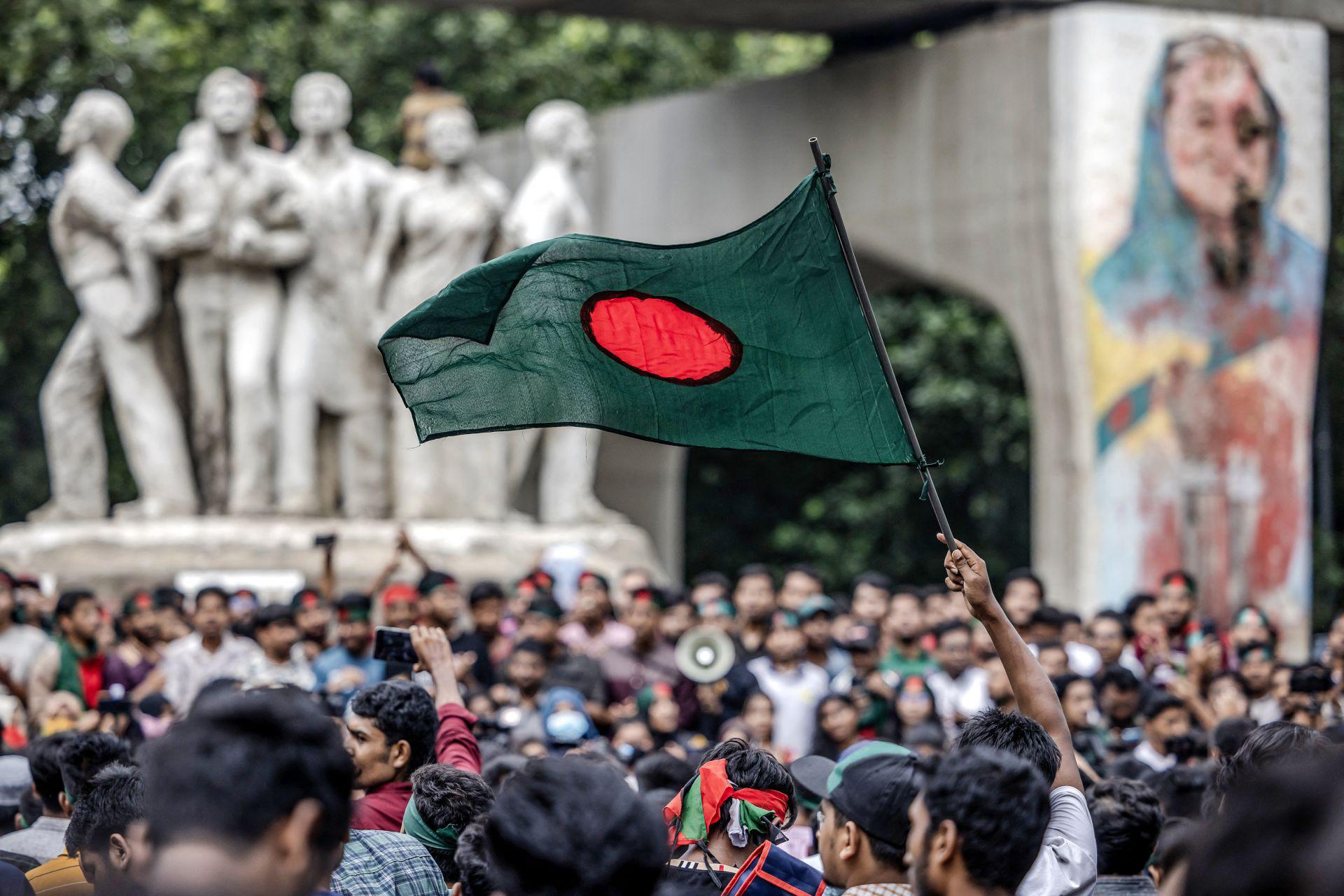
What happened during the protests?
Students were outraged by the reinstatement of the quota system. They believed that it was unfair that 50 years after the war, essential and relevant jobs were being “handed out” to distant relatives of the veterans. For many Bangladeshi citizens and students, the reinstatement of the quota was just the tip of the iceberg. In the past, Bangladesh has been
Immediately after the reinstatement of the quota, student protests began. Students stopped appearing in classes and began appearing in the streets of cities nationwide. Almost instantly after the beginning of the demonstrations, tensions increased, and peaceful rallies would soon turn violent. Students held up signs, chanted lines, and sang songs protesting the necessity and details of the quota. President at the time, Sheikh Hasina, came out and called the protesters “Razakars.” Razakar means volunteer in Persian, but in Bangladesh, it is used as a term for supporters of the Pakistani forces against the nation Bangladesh. At first, the protesters were disgusted by the title. But soon, they adopted it and adorned it proudly. They would chant the name and use it to symbolize their hate for the current government. Though the name-calling did not trigger an instant change, it symbolized a shift in
the movement’s purpose. It no longer focused solely on the quota but pushed for a complete overhaul of the current political cabinet.
Seeing the size and passion of the protests, Hasina and her supporters knew a change had to be made for them to remain in power. Hasina supported and passed an amendment to the quota, which lowered it to just five percent of government jobs. Hasina assumed this move would end the protests but only reinvigorated them. The students began demanding that the quota be abolished entirely, all arrested protesters be set free, and all police-involved be put on trial. It appeared as though nothing would be enough for these protesters. It is essential to mention that by this point, hundreds of protesters had been killed, thousands arrested, and many more injured.
The culminating point of the protests came on August 5th, 2024. After consistent demonstrations, rallies, and marches, Sheikh Hasina and her close cabinet fled the country and abandoned o!ce. Hasina fled to India, and students soon overran her homes and o!ces. The students robbed, vandalized, and destroyed everything that was left behind.
What is left after the collapse, and what is next?
Shortly after the former president’s res-
ignation, Muhammed Yunus took over as interim president. Yunus is a Nobel Prize winner and a supporter of student protests. He knew an interim government would need to be organized and stepped up to put the process in motion. He aims to maintain peace, avoid conflict, fight corruption, and prepare for a new election. Yunus’s cabinet includes multiple student-leaders from the protest and has received much support from Bangladeshi citizens. There is no o!cial date for new elections, but the interim o!ce knows they cannot stay for much longer.
The nation is starting to make its total return towards everyday living. Many colleges have reopened their classrooms, and students are slowly returning. Some university leaders have had to step down due to their support of Hasina. All curfews and police assignments have been lifted, and many storefronts and businesses nationwide have reopened. The future of Bangladesh is still being determined. No significant steps towards a new government have been taken, and the country’s economic data is still not improving. On the bright side, most citizens are happier with the new government, which is much better for the people. Only time will tell if Bangladesh can fully regroup and get back on track after its student protests and government shutdown.
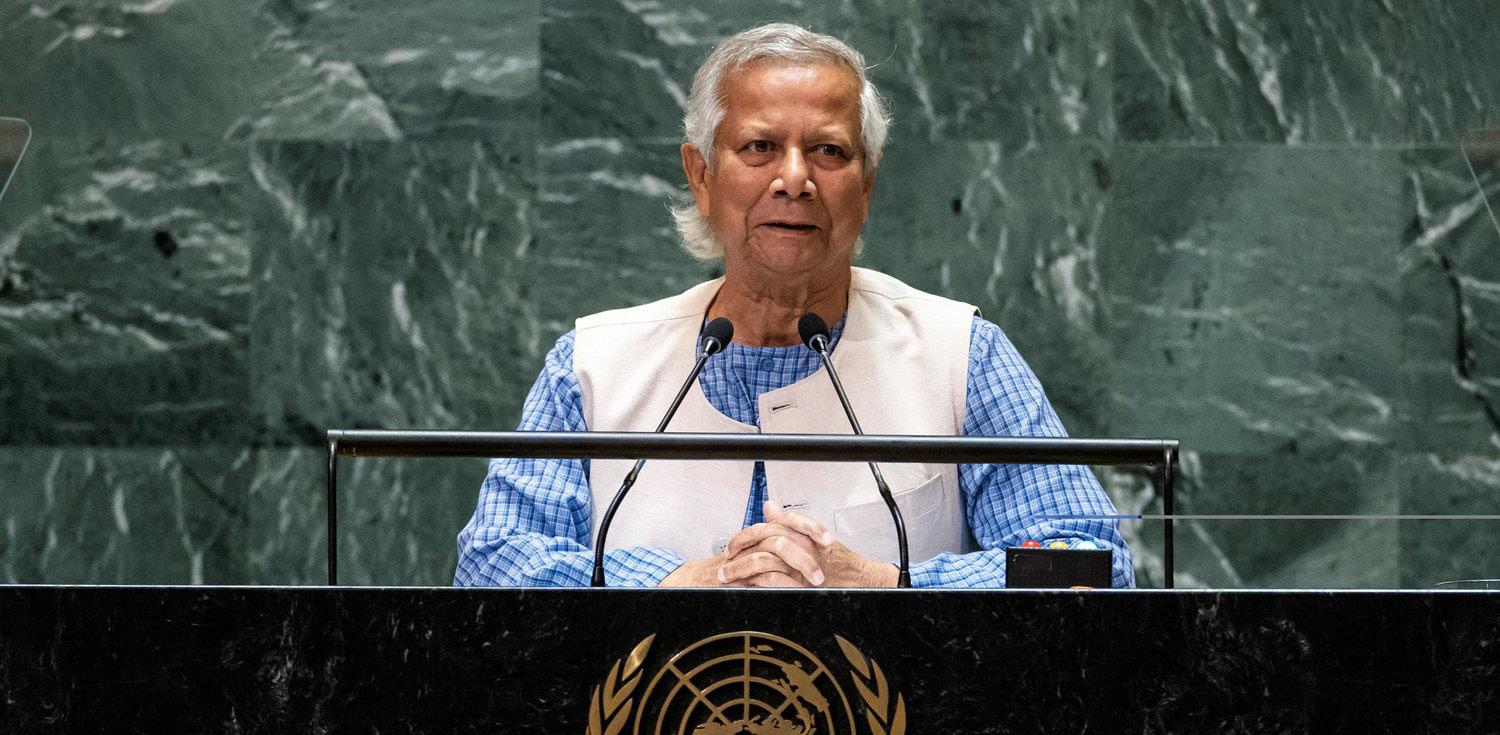
Elon Musk’s Contribution to the Trump Campaign
that he wasn’t sure he even wanted to explicitly endorse Trump.
Elon Musk, the richest man on earth, has set a new precedent for how billionaires influence elections. In the weeks/months prior to the Nov. 5 election, he e ectively moved his base of operations to Pennsylvania, the place that he told confidants he believed was the linchpin to Trump’s re-election. He relentlessly promoted the Republican candidate to his 206 million followers on X, the social platform formerly known as Twitter that he bought for $44 billion and has used to spread conspiracy theories about the Democratic Party. Above all, he personally steered the actions of a super PAC that he has funded with tens of millions of dollars to turn out the vote for Trump, not just in Pennsylvania but across the country.

Taken together, a clear picture emerges of Musk’s battle plan as he directed his e orts to elect Trump with the same frenetic energy and exacting demands that he honed at his companies SpaceX, Tesla, and X.
As early as February, Musk spoke apocalyptically in private, about what he considered the crucial need to defeat President Biden. But even as he was meeting with advisers in Austin, Texas, in April to plot his super PAC, Musk sounded as if he considered Trump merely the lesser of two evils. He told friends in the spring
But recently, in private conversations, Musk became obsessive, almost manic, about the stakes of the election and the need to see the conservative candidate win. He praised Trump’s courage under fire — endorsing him on the night of his first assassination attempt in Butler — and praised his humor. One Tesla o!cial who had spoken recently with Musk recalled him saying, without any hint of irony, “I love Trump.” Musk’s frenzied engagement reflects his view of this moment in American history. On X, he warned in dire terms about the e ects of progressive policies and censorship. He has claimed, without basis, that Democrats are trying to fill the country with undocumented immigrants who would reward them with permanent power, warning that the 2024 race could be the last free election in America.
It may be impossible to capture the financial value of all the support Musk provided to Trump. This is in part because of his role on X, where he amplified so much of the former president’s message. Trump has privately used grand — and unverified — terms to describe Musk’s contribution to the super PAC, telling one associate recently that the figure is $500 million.
But friends and colleagues say Musk adopted the same strategy that he has used during other crises he has considered existential. Just as Musk worked late into the night as his companies teetered on the verge of catastrophe, tinkering with rocket designs at SpaceX, sleeping on a couch in the Tesla factory, or making sta cuts at Twitter, Musk deemed the election an all-hands-on-deck moment.
And so, just as he recruited friends, family, and trusted lieutenants to Twitter after he bought the company, Musk did the same at America PAC, which he founded to help Trump. Most recently, Musk added Steve Davis, a former SpaceX engineer and the head of his tunneling company, to the group, with Mr. Davis reprising a sidekick role that he played after Musk’s takeover of Twitter.
Ensconced in a war room in Pittsburgh with a team of lawyers, public-relations professionals, canvassing experts, and longtime friends, Musk applied strategies and entrepreneurial lessons from his businesses to a grindit-out political mission to his approach to Election Day.
The relationship between Trump and
Musk has evolved over time. Musk, who once privately called Trump a “stone-cold loser,” possesses in abundance the things Trump values most: wealth, fame, and a massive platform. Musk initially supported Gov. Ron DeSantis of Florida for president and suggested that Trump should “sail into the sunset.” Trump in turn replied that Musk begged on his knees for government subsidies. Still, Trump has remained fascinated by Musk.

Politics in the Olympics
Lucien Davis ‘26, Henry Ramanthan ‘26
The Olympic games were established as a festive means to thaw diplomatic tensions and foster cosmopolitanism. Unfortunately, many recent games have undermined this original essence and fully exposed the power politics behind the world’s most beloved event. That is not to say that political issues are new to the games. The 1936 Berlin Games became the set for Hitler’s glorifying display of his much-scrutinized regime as he attempted to showcase Aryan superiority. He became the first of many to use the Olympics to legitimize a corrupt, ill-perceived autocracy. In 1956, the Melbourne Games were the stage for boycotts, as countries condemned the Soviet invasion of Hungary and the Suez Canal Crisis Boycotts at the Olympic Games amplified into the Cold War. The 1980 Moscow Olympics and the 1984 Los Angeles Olympics were stages for boycotts between opposing Cold War blocs. The Games made global political division clearer than ever, forcing countries to stand on either side of the line. At the same time, both blocks were more determined than ever to outperform the other, sparking a now infamous run of doping from the East Germans. Then, the Olympics were largely a ected by political controversy. Now, in the 21st century, they seem to create the controversy. The 2014 Olympics were awarded to Russia, despite their lack of a serious winter sports tradition and Putin’s increasing authoritarianism. After the event,
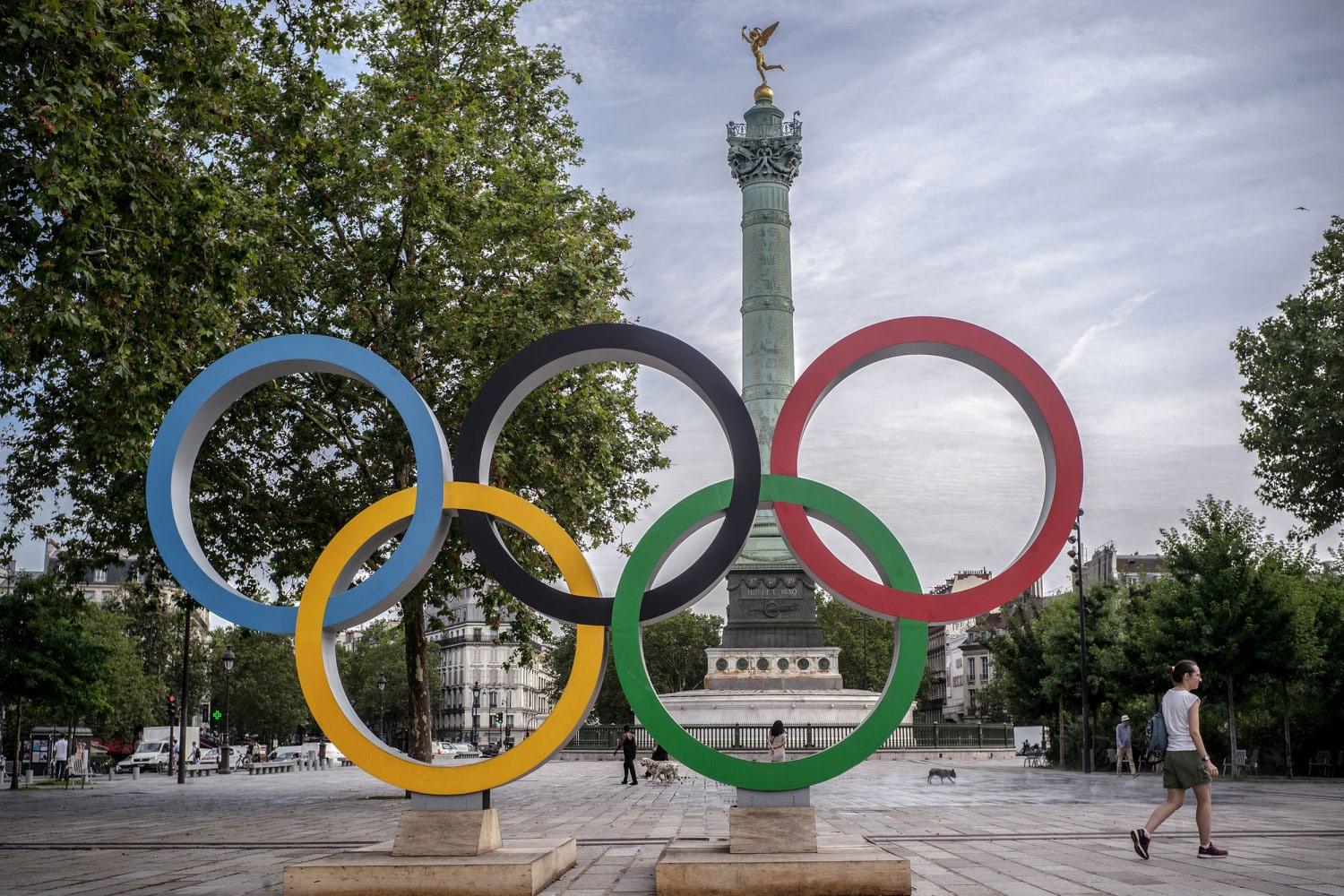
reports revealed that the Kremlin devised a mass, systemic doping scheme involving over a thousand Russian athletes. Only days after the closing ceremony, Putin sent forces to annex Crimea from Ukraine much the same as it did in eastern Ukraine during the 2008 Beijing games. Despite these atrocities, Russia was permitted to compete at the 2016 Rio Olympics. The Olympic committee finally responded in 2017, obliging Russia to compete under the name The Russian Olympic Committee (ROC). Accusations of fraud amplified when Beijing, the 2008 Summer Olympics host, was awarded the 2022 Winter Olympics. This choice of venue for high alpine events raised eyebrows. Later, reports of Uyghur persecution incited calls to boycott the games and protest all over the world. In Russian fashion, the Chinese threatened to invade Taiwan shortly after the Olympics. Chinese o!cials apparently asked Russia to postpone their invasion until after the Olympics, seemingly aware of Putin’s plans weeks before the rest of the world. This marked the third Russian invasion with Olympic timing. With the IOC handing opportunities and second chances to autocracies with poor human rights records, many question if fraud is at play. Are the Olympics becoming a tool for dictators to legitimize their regimes? Have politics irreversibly infiltrated the Olympic games?
The controversy was certainly felt last summer as Taiwan entered as ‘Chinese Tapei’ amidst growing fears of invasion while the ROC competed despite Russia’s war in Ukraine.
To add on, The International Olympic Committee banned both Belarus and Russia from competing under their national flags, citing their involvement in the invasion of Ukraine. Russia had to face a somewhat similar punishment during the last Olympics when they manipulated doping data. Nevertheless, Russian and Belarusian athletes were allowed to compete against other countries under a neutral status. To penalize both countries further, the International Olympic Committee required the athletes to distance themselves from the war and any military matters, e ectively silencing them from making any political statements. In addition, the athletes were scarcely shown or put into the spotlight. Considering that Russia (o!cially the ROC during the last Olympics) placed fifth place in 2020, many considered this a monumental decision. Multiple fronts on both sides disagreed with the decision; Ukraine and several others felt as if all Russian and Belarusian athletes should have been banned even under a neutral status, quoting that they
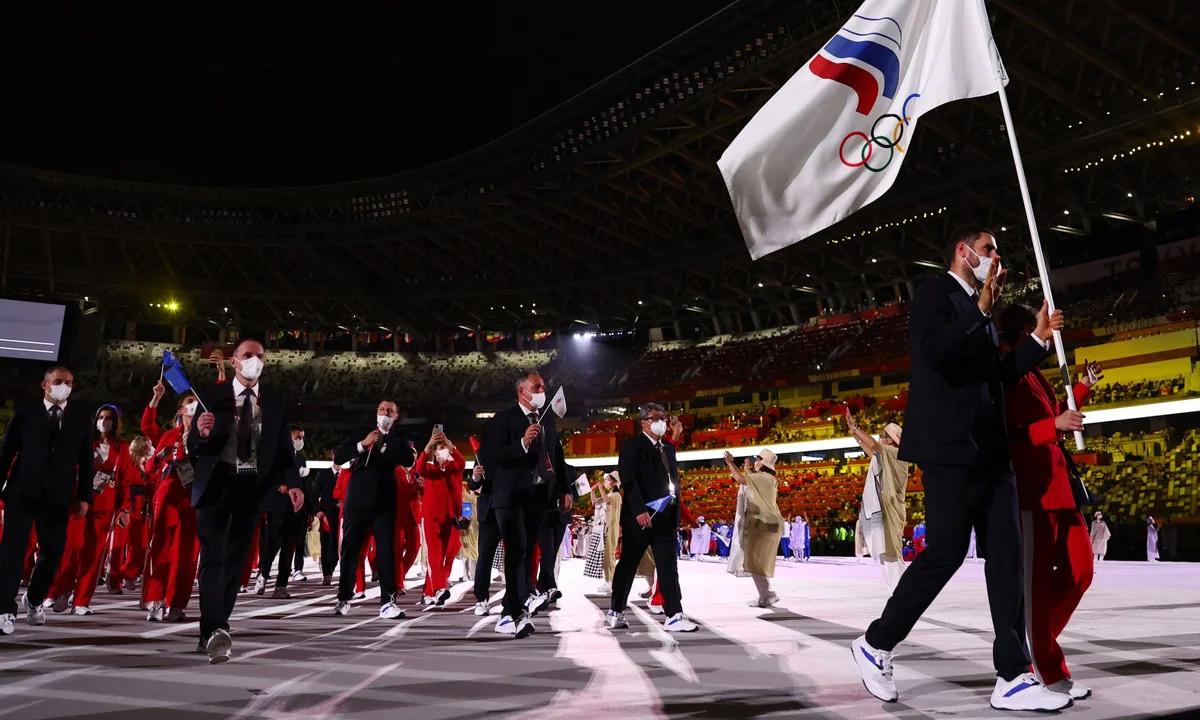
feared the International Olympic Committee was normalizing Russia’s actions. Conversely, Russia called out the Committee, condemning their decision as “discriminatory” and politically motivated. Russian o!cials also made aggressive comments against the Committee. Putin himself called out the Committee for wrongfully spreading anti-Russian propaganda and even claimed he pondered whether it was even worth it to compete at all. For a man like Vladimir Putin, who has tried to produce a strong and powerful Russian image in the past, this decision marks a vicious stain on the Russian’s athletic reputation.
Moving on, another area of controversy was Israel’s participation in the games. Amid their conflict with Palestine, many called for Israel to be banned from participating in the games or to at least face the same sanctions as

Russia for their war crimes. Despite pro-Palestinian activists calling for a punishment of some sort, the Internation Olympic Committee remained stern and steadfast in allowing Israel to compete in the games. Given the tensions of the war, Israeli athletes were provided with extensive security measures to ensure their safety, as French authorities allocated thousands of o!cers and soldiers to specifically protect the athletes. Despite this Committee’s warm embrace of Israel, many other athletes from Arab countries such as Morocco and Algeria refused to shake hands with Israeli opponents. The athletes also reported receiving death threats and multiple anti-Israel banners were displayed. During the opening ceremony, a symbolic moment of unity and celebration, Israel’s national anthem was booed.
The International Olympic Committee’s stance on politics remains clear: remain away from politics when possible, but enforce punishment when needed. The Committee strives for “unity, peace, and the celebration of the sport”. Amid ongoing conflicts between nations, the decision on whether or not punishment should be imposed, and if so how severe, becomes challenging. This year, wars and violent disputes marked the center of controversy, and we were once again reminded of the Olympics’ inevitable twist with politics.


